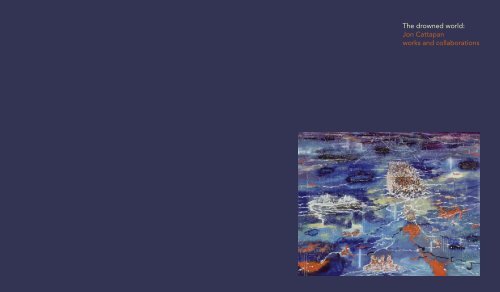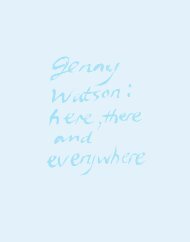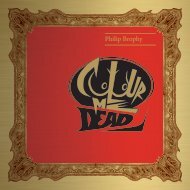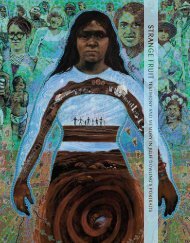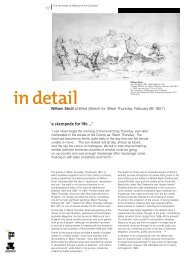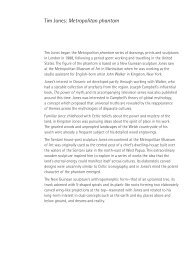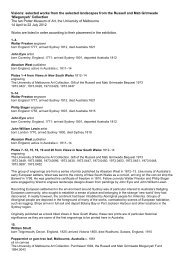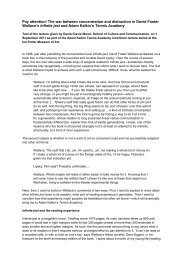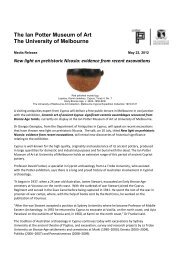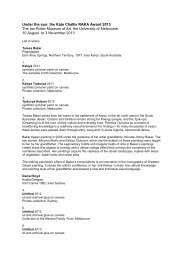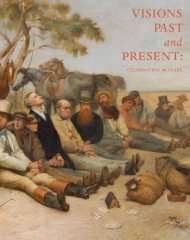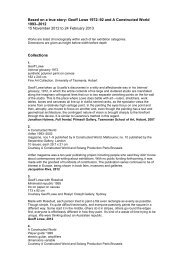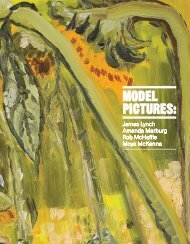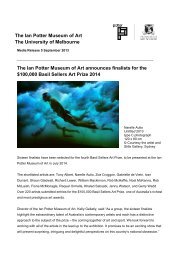The drowned world Jon Cattapan works and collaborations
Catalogue - Ian Potter Museum of Art - University of Melbourne
Catalogue - Ian Potter Museum of Art - University of Melbourne
- No tags were found...
You also want an ePaper? Increase the reach of your titles
YUMPU automatically turns print PDFs into web optimized ePapers that Google loves.
<strong>The</strong> <strong>drowned</strong> <strong>world</strong>:<br />
<strong>Jon</strong> <strong>Cattapan</strong><br />
<strong>works</strong> <strong>and</strong> <strong>collaborations</strong>
inside<br />
back<br />
cover
<strong>The</strong> <strong>drowned</strong> <strong>world</strong>:<br />
<strong>Jon</strong> <strong>Cattapan</strong><br />
<strong>works</strong> <strong>and</strong> <strong>collaborations</strong>
Contents<br />
4 Foreword<br />
Robert McKay<br />
5 <strong>The</strong> <strong>drowned</strong> <strong>world</strong><br />
Dr Chris McAuliffe<br />
12 <strong>The</strong> group discusses<br />
Dr Karen Burns, <strong>Jon</strong> <strong>Cattapan</strong>, Dr Chris Healy <strong>and</strong> Tom Nicholson<br />
20 Plates<br />
50 <strong>Jon</strong> <strong>Cattapan</strong>—biography <strong>and</strong> bibliography<br />
54 Catalogue of <strong>works</strong> in the exhibition
Foreword<br />
Robert McKay<br />
Chairman of the Ian Potter Museum of Art Board<br />
In 2005, <strong>Jon</strong> <strong>Cattapan</strong> played a small, but significant, part in the presentation of a survey<br />
of the art of Gareth Sansom at the Potter. Speaking at the opening of that exhibition,<br />
<strong>Cattapan</strong> reflected on the early support Sansom had given him in his own career <strong>and</strong><br />
reminded us of the importance of acknowledging the generosity <strong>and</strong> achievement of senior<br />
artists. With this exhibition, we in turn must acknowledge <strong>Cattapan</strong>’s achievements in over<br />
twenty-five years as an artist.<br />
<strong>The</strong> <strong>works</strong> in this exhibition traverse Melbourne, Sydney, Canberra, the US, Korea, India<br />
<strong>and</strong> Italy. Not surprisingly, given <strong>Cattapan</strong>’s wide-ranging exhibition record, it is the first time<br />
that some of these major paintings have been shown in Melbourne. Commencing with a<br />
painting made while <strong>Cattapan</strong> was still a student <strong>and</strong> concluding with a large, new triptych,<br />
this exhibition is a record of studio practice, research, teaching <strong>and</strong> international exchange.<br />
In it, we can see the ways in which <strong>Cattapan</strong> <strong>and</strong> his peers have developed an ambitious<br />
Australian art, embracing local <strong>and</strong> international experiences, exploring new technologies<br />
<strong>and</strong> ideas, <strong>and</strong> grappling with the personal <strong>and</strong> moral challenges of global culture.<br />
Our sincere thanks go to <strong>Jon</strong> <strong>Cattapan</strong> for his enormous dedication to this project. We would<br />
also like to acknowledge the support of the exhibition catalogue by Vasili Kaliman <strong>and</strong> Irene<br />
Sutton through the Potter’s 2006 Donor Program. As well, we are grateful to the many public<br />
<strong>and</strong> private lenders who have generously loaned work to <strong>The</strong> <strong>drowned</strong> <strong>world</strong> from<br />
Melbourne, Sydney <strong>and</strong> Brisbane. And finally, my thanks go once again to the many Potter<br />
staff who have worked to realise this major exhibition <strong>and</strong> catalogue at the museum.<br />
4
<strong>The</strong> <strong>drowned</strong> <strong>world</strong><br />
Dr Chris McAuliffe<br />
Director <strong>and</strong> exhibition curator<br />
<strong>Jon</strong> <strong>Cattapan</strong>’s art frequently commences from personal<br />
experience—a fleeting instant in everyday life, a<br />
significant personal crisis, or deeply held belief—so he<br />
has a wealth of stories to tell. <strong>Cattapan</strong>’s practice is<br />
inseparable from tales both private <strong>and</strong> public: a<br />
succession of relationships, artistic partnerships,<br />
localities <strong>and</strong> residences; a deepening engagement<br />
with his materials <strong>and</strong> an embrace of new technologies;<br />
<strong>and</strong> a career traversing the boom/bust/recovery rhythm<br />
of the 1980s <strong>and</strong> 1990s.<br />
<strong>Cattapan</strong>’s sources are unselfconsciously revealed.<br />
Paintings were made in response to the <strong>world</strong> outside<br />
his window, to jarring life events, <strong>and</strong> to the impact of<br />
artists such as Bosch or Tanguy. <strong>The</strong>se are, so to speak,<br />
the internal points of commencement; life, love <strong>and</strong> the<br />
lure of art itself. Less familiar, but nevertheless<br />
ubiquitous, origins also lie in cinema, digital<br />
technologies <strong>and</strong> travel. <strong>The</strong>se point to origins in the<br />
new terrain of globalization <strong>and</strong> digital culture.<br />
Commencing art school in 1975, <strong>and</strong> maturing over the<br />
course of the 1980s, <strong>Cattapan</strong> is on the cusp of the<br />
modern <strong>and</strong> the postmodern. One of modernism’s<br />
classical motifs—the social experience, in extremis, of<br />
the individual within the metropolis—propelled his work<br />
from the outset. And a melancholic fascination with<br />
seductively decrepit cities, inherited from Charles<br />
Baudelaire, Walter Benjamin <strong>and</strong> JG Ballard, continues<br />
to colour his art. Likewise modernism’s other great<br />
theme—the life of the unconscious, the libidinal<br />
economy of desire—is evident in <strong>Cattapan</strong>’s oily<br />
dreamscapes.<br />
Simultaneously, <strong>Cattapan</strong>’s art shows signs of the<br />
emergence of postmodern culture: ‘the change from<br />
atoms to bits’. 1 His cityscapes are fragmented, mobile,<br />
excessively mediated, <strong>and</strong> dematerialized. <strong>The</strong><br />
apocalyptic tone of fin-de-siècle postmodernism has<br />
shaped discussion of <strong>Cattapan</strong>’s work, but the best<br />
itemisation of his iconography is the fine print of a<br />
domestic insurance policy: fire, flood, theft, injury, act of<br />
God. Shit happens, <strong>and</strong> it doesn’t stop happening.<br />
<strong>Cattapan</strong> looks on in fear <strong>and</strong> fascination.<br />
<strong>Cattapan</strong>’s watery canvases suggest the slippery<br />
virtuality of postmodern experience. His many images<br />
of surveillance allude to the paranoid experience of<br />
digital culture. <strong>The</strong> paintings survey the intense but<br />
indistinct terrain of the dream. <strong>The</strong> sci-fi allegories of<br />
Philip K Dick—everyday life in a city teetering on the<br />
brink of techno-abyss—are there, but also the brutal<br />
<strong>and</strong> seductive effrontery of Surrealism’s merveilleux<br />
(marvelous).<br />
<strong>Cattapan</strong> is both a realist <strong>and</strong> a symbolist, an observer<br />
<strong>and</strong> a dreamer. His deluge is allegorical; ours is a <strong>world</strong><br />
swamped with information. But it is also a real flood,<br />
one that found the artist waist deep in water on a St<br />
Kilda street in 1989. His conflagrations are not only<br />
Freudian symptoms but real blazes in East Melbourne,<br />
St Kilda <strong>and</strong> Footscray, which brought down a church, a<br />
town hall <strong>and</strong> a chemical factory respectively. <strong>Cattapan</strong><br />
revels in the digital—he produces sketches using a<br />
scanner <strong>and</strong> Photoshop software—but he speaks in the<br />
analog media of painting <strong>and</strong> drawing.
Cat. 1 Bananas 1977–78<br />
<strong>Cattapan</strong> is more inclined to mark the stages of his<br />
development with references to pop <strong>and</strong> street culture<br />
than to artistic epiphanies. <strong>The</strong> first, <strong>and</strong> still one of the<br />
most important of these was the irruption of punk rock<br />
within Melbourne’s music, fashion <strong>and</strong> literary scenes.<br />
<strong>The</strong> brash, do-it-yourself attitude of punk was liberating<br />
for a young student still unsure of his capacities <strong>and</strong><br />
qualities as an artist; ‘We felt like anybody could get<br />
up <strong>and</strong> have a go at it’.<br />
A sense of creative community developed, <strong>and</strong> with it,<br />
the first of the geographical <strong>and</strong> social territories that<br />
would appear in <strong>Cattapan</strong>’s work: ‘It was very interesting<br />
living in St Kilda in the early ’80s because you didn’t<br />
just have visual artists. You had young writers <strong>and</strong> young<br />
musicians, <strong>and</strong> they all talked to each other. You had<br />
one café that everyone went to, the Galleon, upstairs<br />
in Acl<strong>and</strong> Street. You’d bump in to half a dozen people<br />
working in different art forms’. 2 Bananas (1977–78),<br />
begun while <strong>Cattapan</strong> was still a student, refers to<br />
another punk hangout: the long-defunct music venue<br />
on St Kilda’s Upper Esplanade. Op shop fashions,<br />
pointy boots <strong>and</strong> sunglasses after dark set the tone<br />
of this <strong>and</strong> other <strong>works</strong> of the late 1970s.<br />
St Kilda’s bohemians didn’t form a movement but punk<br />
gave legitimacy to the raw, emotional style that<br />
<strong>Cattapan</strong> <strong>and</strong> his friend Peter Ellis were developing.<br />
Repressed <strong>and</strong> forgotten aspects of modernism<br />
reappeared; the expressionist James Ensor was a<br />
favourite. <strong>The</strong> return to figuration sweeping European<br />
art was echoed in the rediscovery of local mavericks<br />
such as Danila Vassilieff. <strong>The</strong> moves seem familiar in<br />
retrospect but were confronting after the cool reserve<br />
of 1970s abstraction <strong>and</strong> conceptualism. Throughout<br />
the first half of the 1980s, critics scolded <strong>Cattapan</strong><br />
as an artist with ‘disturbing <strong>and</strong> macabre fantasies’<br />
<strong>and</strong> ‘much sorting out to do’. 3<br />
For <strong>Cattapan</strong>, the studio <strong>and</strong> the street were just the<br />
place to sort things out. Outside his flat on Grey Street,<br />
St Kilda, there was never a dull moment. Haggard faces,<br />
eviscerated bodies <strong>and</strong> eerie toy-like figures all<br />
registered the rough poetry of late nights <strong>and</strong> long<br />
parties.<br />
By the mid-1980s, <strong>Cattapan</strong>’s urban imagery had<br />
become less confronting. Time spent in Europe<br />
in 1978 had amplified punk <strong>and</strong> expressionistic<br />
impulses. A second sojourn in 1985 lead to a deliberate<br />
decision to focus on the psychological spaces of the<br />
city. Some significant formal strategies were developed<br />
to pursue this goal. <strong>The</strong> grounds of the paintings<br />
became open, flattened fields of aqueous colour.<br />
Localities <strong>and</strong> incidents hovered in indistinct spaces,<br />
popping into focus with the sharp but jumpy clarity<br />
of a dream. Physical forms, such as people <strong>and</strong><br />
buildings, became more schematic as <strong>Cattapan</strong> forged<br />
a kind of Freudian hieroglyphics which referred to<br />
home, desire <strong>and</strong> travel through simple outlines <strong>and</strong><br />
silhouettes. <strong>The</strong> gridded drawings of the early 1980s<br />
grew into large, multi-panel canvases—the reactive<br />
studies—each of which offered a ‘screen in screen’<br />
detail or commentary on an adjacent event.<br />
Name <strong>and</strong> address (1988), was still based on St Kilda’s<br />
nocturnal theatre. Still living on Grey Street, <strong>Cattapan</strong><br />
witnessed a police sweep in which entire blocks were<br />
closed off while pedestrians were questioned. This<br />
moment has haunted <strong>Cattapan</strong>’s art since. <strong>The</strong> elevated<br />
point of view that dominates the later cityscapes<br />
is there, as is the gloomy dream twilight. While the<br />
incident involved a crude round-up, rather than<br />
sophisticated technological surveillance, there is an<br />
air of Orwellian social control. <strong>The</strong> painting is a<br />
harbinger of later <strong>works</strong>, such as Curtain line (Australian<br />
crowd no. 2) (2001) <strong>and</strong> <strong>The</strong> taking of Richmond (1999),<br />
in which containment <strong>and</strong> the confrontation of<br />
communities take on an explicitly political cast.<br />
Cinema showed <strong>Cattapan</strong> the way at this time.<br />
Scorsese’s Mean streets (1973) <strong>and</strong> Taxi driver (1976)<br />
mapped the city’s heart of darkness. Fellini’s Roma<br />
(1972) presented the eternal city as a movable feast of<br />
history, memory <strong>and</strong> sexuality. And Hitchcock revealed<br />
the Freudian subtexts of urban life, in dramatic<br />
eruptions of sex <strong>and</strong> violence from beneath the banal<br />
surface of the everyday.<br />
<strong>Cattapan</strong>’s cities became increasingly abstract over the<br />
course of the 1990s. An extended stay in New York in<br />
1989–90 had the paradoxical effect of dissolving, rather<br />
than consolidating, his vision of urban space. Paintings<br />
such as Documentary (Melbourne as Rome) (1989)<br />
had fantasized about life in a cosmopolitan metropolis.<br />
Real life in a mega-city was so overwhelming that<br />
<strong>Cattapan</strong> sought solace in canvases emptied of<br />
incident, like Dog day (Seep) (1991), or, as in the case<br />
of Double ellipse (from ‘<strong>The</strong> city submerged’) (1991),<br />
dissolved the city into a droplet of oily colour.<br />
6
Cat. 33 Name <strong>and</strong> address 1988<br />
Paradoxically, the other defining characteristic of life in<br />
New York was its small scale. Life was patterned around<br />
spaces in Williamsburg (the studio), the Lower East Side<br />
(the apartment), Little Italy <strong>and</strong> the East Village<br />
(nightlife). <strong>The</strong> isolated incidents of the large paintings<br />
<strong>and</strong> reactive studies were now scattered over myriad<br />
small sheets of paper, so that the city became a<br />
constellation of moments scattered across a wall-length<br />
installation.<br />
Increasingly, <strong>Cattapan</strong>’s urban imagery echoed<br />
descriptions of the postmodern city. Composite,<br />
mobile <strong>and</strong> fragmented, this city of flows <strong>and</strong> vectors<br />
embodied an increasingly digital <strong>and</strong> global<br />
environment. <strong>The</strong> ongoing <strong>The</strong> city submerged<br />
installation constantly reconfigures the city as an array<br />
of instants. <strong>Cattapan</strong>’s aerial views montaged buildings<br />
from multiple cities into generic centres of ‘the bit<br />
radiation business’. 4 His palette mimicked the RGB<br />
(red, green, blue) of the computer monitor, <strong>and</strong> pixellike<br />
dots form a veil over the surface of the canvas.<br />
Curious signs of social transition began to appear:<br />
a member of the gathered crowd in Woden waiting<br />
(1992–93) uses a mobile phone, perhaps the first entry<br />
of this now common device into painting. And in<br />
<strong>The</strong> bookbuilder (1992), the earlier communications<br />
revolution—the printed word—is exiled to the sidelines,<br />
overwhelmed by the city of bytes.
Cat. 60 <strong>Jon</strong> <strong>Cattapan</strong> <strong>and</strong> Surendran Nair<br />
Untitled (Matter drawings, Baroda/Melbourne) 1996–97<br />
<strong>The</strong> Bookbuilder, Fuse (1994), <strong>and</strong> Skeletal (1995) mark<br />
the development of a cyber-sublime. <strong>Cattapan</strong> was one<br />
of a generation for whom Ridley Scott’s Blade runner<br />
(1982) was an Urtext. Just as the shock <strong>and</strong> awe of an<br />
avalanche was the cue for terrified reverie in the<br />
eighteenth-century l<strong>and</strong>scape, so the layered chaos of<br />
street <strong>and</strong> cosmos was the postmodern terribilità. Blade<br />
runner offered a seductive vision to artists <strong>and</strong> theorists<br />
alike. David Harvey’s paean to the film could serve as a<br />
description of <strong>Cattapan</strong>’s paintings: ‘<strong>The</strong> chaos of signs,<br />
of competing significations <strong>and</strong> messages, suggests a<br />
condition of fragmentation <strong>and</strong> uncertainty at street<br />
level ... Images of creative destruction are everywhere’.<br />
More significant, in terms of the paintings to come, was<br />
Harvey’s observation that a hallmark of the film was ‘the<br />
sense of shattering <strong>and</strong> fragmentation of social life’. 5<br />
As globalization came to dominate both artistic <strong>and</strong><br />
social consciousness, the foundations in localities—<br />
both actual <strong>and</strong> mythological—that <strong>Cattapan</strong> had built<br />
for his practice were threatened. <strong>The</strong> mobility of the<br />
individual <strong>and</strong> the mutability of the image meant that<br />
‘<strong>The</strong> places associated with home, with the Self, <strong>and</strong><br />
with identity are being replaced by places that ought to<br />
look different but are in danger of not doing so ... [I]t is<br />
apparently the burden of some of us in the <strong>world</strong> to<br />
consume difference while others are condemned<br />
historically to supply that difference’. 6<br />
Embarking on a series of residencies, <strong>and</strong> working<br />
within Australia’s university system, <strong>Cattapan</strong> lived in<br />
Ohio, Canberra, Sydney, Melbourne, Seoul <strong>and</strong> Baroda.<br />
Working collaboratively forced <strong>Cattapan</strong> into direct<br />
communication with local artists <strong>and</strong> did something<br />
to dilute the distinction between consumers <strong>and</strong><br />
producers of difference. In h<strong>and</strong>ing over a drawing or<br />
watercolour to Surendran Nair in Baroda, <strong>Cattapan</strong><br />
ceded his territory to the local. <strong>The</strong> returned drawings,<br />
completed by another h<strong>and</strong>, encapsulated both the<br />
openness <strong>and</strong> disorientation of the traveler. <strong>The</strong> artist<br />
had to be willing to welcome the new <strong>and</strong> to allow the<br />
unfamiliar to occupy his work. At the same time, he was<br />
able to recreate the sense of intense community <strong>and</strong><br />
partnership that had driven his earlier collaborative<br />
drawings with Peter Ellis. This openness <strong>and</strong> partnership<br />
through drawing holds also for his 2001 collaboration<br />
with Eugene Carchesio.<br />
Drawing had always been the bedrock of <strong>Cattapan</strong>’s<br />
work, travel only increased its significance. Small-scale,<br />
immediate work is both a practical <strong>and</strong> metaphorical<br />
solution to the challenges of travel. Drawings are easily<br />
made <strong>and</strong> portable. Quick notations register the impact<br />
of new experiences when there is no time to digest<br />
them fully.<br />
In spite of their humble physical nature, the drawings<br />
reveal key characteristics of <strong>Cattapan</strong>’s practice.<br />
Meaning is generated by isolated symbols. Often<br />
heraldic or totemic in their nature, these symbols recall<br />
both the icons of the Italian Trecento <strong>and</strong> the fetishised<br />
found objects of Surrealism. Typically, they are human in<br />
scale or in derivation—the body itself, or items that can<br />
be held in the h<strong>and</strong>—in order to counterbalance the<br />
overwhelming sweep of global vistas.<br />
This recovery of the human within the global became<br />
a dominant concern for <strong>Cattapan</strong> at the turn of the<br />
millennium. His reflections on the city had taken him to<br />
writers like Richard Sennett, who lamented the loss of<br />
a neutral civic realm in the age of privacy <strong>and</strong> intimacy. 7<br />
Against the private realm, Sennett argued for the<br />
benefits of a society of strangers, supported by public<br />
institutions; in effect, a healthy society premised on<br />
citizens recognizing their need for each other without<br />
having to know each other.<br />
This model, which found hope in an impersonal social<br />
institution, takes shape in the small clusters of citizens<br />
who gather in <strong>Cattapan</strong>’s paintings, often against a<br />
back-drop of civic buildings. More specifically, the neoliberalism<br />
of Victoria’s Kennett government brought the<br />
politics of public spaces <strong>and</strong> institutions to the fore in<br />
<strong>Cattapan</strong>’s art. <strong>The</strong> taking of Richmond condenses<br />
events <strong>and</strong> ideologies provoking this turn to community<br />
politics. Richmond Secondary College was one of the<br />
many state schools closed or restructured during the<br />
Kennett era. Parents <strong>and</strong> community members<br />
occupied the school in protest for 360 days, before<br />
being forcibly evicted in a baton charge later described<br />
as an ‘unreasonable’ action using ‘excessive force’. 8<br />
8
Cat. 76 Psychasthenia 101 (video) 2005
Cat. 69 Carrying 2002<br />
<strong>The</strong> force of the state response to this <strong>and</strong> other<br />
community protests, raised suspicions that, ‘Whenever<br />
there is genuine opposition by members of the<br />
community to the government, the police are there’. 9<br />
Where police actions were once limited to, <strong>and</strong><br />
expected in, the red light districts of St Kilda, now, it<br />
appeared, they were to appear wherever policy or<br />
ideology was to be enforced.<br />
<strong>The</strong> promise offered by the rediscovery of community<br />
is forced, however. Boundaries <strong>and</strong> national<br />
mythologies were reinstated at the same time. In 2001,<br />
‘<strong>The</strong> w<strong>and</strong>ering winds of Tampa talk-back blew into<br />
some very dark corners of the Australian psyche’. 10<br />
<strong>The</strong> ‘children overboard’ affair heralded, variously, the<br />
defeat of small-L liberalism, an Opposition in lockstep<br />
with the government, the politicization of both the<br />
public service <strong>and</strong> the military, <strong>and</strong> the disheartening<br />
spectacle of a Norwegian seaman more au fait with<br />
the Australian notion of a fair go than Australians<br />
themselves. Carrying (2002) grapples with the<br />
event itself, while Curtain line (Australian crowd no. 2)<br />
charts its aftermath; a pallid citizenry huddled within<br />
Australia’s coastline, weighed down by the rhetoric of<br />
border protection.<br />
With the liberal-pluralist social contract giving way to<br />
Realpolitik <strong>and</strong> xenophobia, <strong>Cattapan</strong>’s early fascination<br />
with the work of JG Ballard re-emerged. Ballard’s<br />
poetics of a postmodern Fall were updated. <strong>The</strong> flood<br />
was now the mooted onslaught of illegal immigrants.<br />
Primitive tribalism <strong>and</strong> paranoia elbowed liberal<br />
democracy aside. <strong>The</strong> ‘children overboard’ affair is<br />
inseparable from a loss of faith in the truth of the image<br />
<strong>and</strong> a witnessing of the degradation of the public<br />
sphere. It is not surprising that <strong>Cattapan</strong>’s figures<br />
become spectral, his grids more forceful <strong>and</strong> enclosing,<br />
his boundaries white-hot.<br />
10
<strong>Cattapan</strong>’s paintings are not pictures of specific<br />
moments of crisis. Indirectly, they take their cue from<br />
Frederic Jameson who, having recognised in Ballard,<br />
‘the contradictions of a properly representational<br />
attempt to grasp the future directly’, proposed that<br />
artists imagine resistant <strong>world</strong>s in a process of<br />
cognitive mapping. 11<br />
<strong>The</strong> connections forged between people are <strong>Cattapan</strong>’s<br />
imagined future. <strong>The</strong>y are presented as tenuous,<br />
all the more so as the source imagery for <strong>works</strong> such as<br />
Psychasthenia 101 (video) (2005) <strong>and</strong> the Carbon group<br />
drawings (2003) is often r<strong>and</strong>omly gleaned from the<br />
daily press. But importantly, the connections are<br />
physical. In <strong>The</strong> fold (2000), the contact is ambiguous;<br />
a struggle or an embrace. It may be gr<strong>and</strong>ly<br />
metaphorical (the biblical tale of Jacob wrestling the<br />
angel) or banal (two footballers in a clinch). <strong>The</strong>re is a<br />
recovery, or a dream of the recovery, of those elements<br />
of community dissolved in the age of privatization,<br />
neo-liberalism <strong>and</strong> self-interest. Communities become<br />
physical <strong>and</strong> local again: artists, activists, residents,<br />
parents, citizens supplant the bohemians <strong>and</strong> jetsetters<br />
of the earlier paintings.<br />
In the <strong>works</strong> of the 1980s, the blaze <strong>and</strong> the flood<br />
were crepuscular, catastrophic <strong>and</strong> fetishised; classical<br />
(the stuff of the Bible or of Bosch) <strong>and</strong> yet ephemeral<br />
(done to death in disaster movies). This was the heart<br />
of <strong>Cattapan</strong>’s l<strong>and</strong>scape; the city laid waste <strong>and</strong> cheap<br />
thrills galore. It’s what we wanted, we fin-de-siècle<br />
Neros; to have a good old fiddle as we watched our<br />
culture burn.<br />
A different collapse, the moral collapse always latent<br />
in Ballard’s superficially sci-fi stories of post-apocalyptic<br />
cities, is the current looming disaster. In response,<br />
<strong>Cattapan</strong> seems intent on rebuilding his <strong>world</strong> from<br />
the ground up. In 2005, he returned to his parents’<br />
province, the Veneto, to the small Italian village<br />
of Mogliano. <strong>The</strong> drawings he made there are small,<br />
attentive <strong>and</strong> poetic. A non-descript mound modeled<br />
on his son’s blanket. Variations on the attenuated<br />
form of a stick insect found in the garden. And, tellingly,<br />
the figure of light—of reason—in a spun aluminium<br />
desk lamp. This is no retreat into the pastoral. Trying to<br />
make sense of the <strong>world</strong>, rather than the comforts of a<br />
settled <strong>world</strong>, is their subject. Drawing breath, <strong>Cattapan</strong><br />
is able to return to qualities in his art that might serve<br />
as ways of shaping the <strong>world</strong>. Fascination is one of<br />
these; a determination to dwell at length on whatever<br />
humble object catches his eye. Affect is another; the<br />
exploration of how <strong>and</strong> why one builds an emotional<br />
anchorage to a thing, a place or a person. Vision,<br />
too; the freedom to see the <strong>world</strong> your way, then<br />
another way, then another.<br />
1 Nicholas Negroponte, Being digital, Hodder & Stoughton,<br />
Rydalmere, NSW, 1995, p. 4.<br />
2 Interview with the artist, September 2005.<br />
3 Ronald Millar, ‘A look below the surface’, <strong>The</strong> Herald, 28 April 1983,<br />
p. 24.<br />
4 Negroponte, op. cit., p. 48.<br />
Cat. 81 ‘Untitled’ from ‘Mogliano suite’ 2005<br />
5 David Harvey, <strong>The</strong> condition of postmodernity, Basil Blackwell,<br />
Oxford, 1989, p. 311.<br />
6 Himadeep Muppidi, <strong>The</strong> politics of the global, University of<br />
Minnesota Press, Minneapolis, 2004, p. 97.<br />
7 Richard Sennett, <strong>The</strong> fall of public man, Cambridge University Press,<br />
Melbourne, 1977.<br />
8 Deputy Ombudsman (Police Complaints) Dr Perry, quoted in David<br />
Baker, ‘Police, policy <strong>and</strong> practice’, in Brian Costar & Nicholas<br />
Economou (eds), <strong>The</strong> Kennett revolution: Victorian politics in the<br />
1990s, UNSW Press, Sydney, 1999, p. 240.<br />
9 Liz Curran, Federation of Community Legal Services, quoted in Baker,<br />
op. cit., p. 241.<br />
10 Guy Rundle, ‘<strong>The</strong> opportunist: John Howard <strong>and</strong> the triumph of<br />
reaction’, Quarterly Essay, no. 3, 2001, p. 6.<br />
11 Frederic Jameson, ‘Progress versus utopia; or, Can we imagine the<br />
future?’, in Brian Wallis (ed.), Art after modernism: rethinking<br />
representation, the New Museum of Contemporary Art, New York,<br />
1984, p. 245.
<strong>The</strong> group discusses<br />
<strong>Jon</strong> <strong>Cattapan</strong> <strong>and</strong> I spent a long time talking about his art while preparing this<br />
exhibition. We realised that this was something missing from the public discourse<br />
about Australian art. <strong>The</strong>re were few opportunities to see people talking about art,<br />
pointing to details, asking the artist questions, floating ideas <strong>and</strong> arguing over<br />
interpretations. So we invited some visitors to <strong>Jon</strong>’s Moorabbin studio. What follows is<br />
an edited transcript, amounting to only one tenth of the full conversation held on<br />
Friday 10 March 2006. Participants are Dr Karen Burns, <strong>Jon</strong> <strong>Cattapan</strong>, Dr Chris Healy<br />
<strong>and</strong> Tom Nicholson.<br />
Dr Chris McAuliffe<br />
12
Cat. 70 <strong>The</strong> group discusses 2002<br />
Dr Chris Healy: Documentary (Melbourne as Rome) [1989]<br />
reminded me of the Phil Noyce film Newsfront, because of<br />
the figure with the 16 mm camera on top of a VW Kombi<br />
van. <strong>The</strong>re’s such a strong documentary logic. <strong>The</strong> impulses<br />
that go with the desire to produce history paintings are<br />
there in a fantastically self-reflective way, because you’re<br />
producing the paintings but also providing us with a way<br />
of thinking about the means of their reproduction in the<br />
image of the cameraman.<br />
<strong>Jon</strong> <strong>Cattapan</strong>: I should ’fess up <strong>and</strong> tell you that I went to<br />
art school as a way of getting into film school. <strong>The</strong>re’s a<br />
Hitchcockian way of framing those earlier <strong>works</strong>.<br />
Healy: It’s almost like you have a spotlight thrown on<br />
various elements in the image.<br />
Dr Karen Burns: It’s a particular representation of urban<br />
life; a nocturnal, slightly green dreamscape of urban life.<br />
Tom Nicholson: <strong>The</strong>re’s obviously a reference to filmmaking<br />
but for me the language is very strongly a painting<br />
language which I would trace back to a certain image<br />
of Melbourne figuration.<br />
<strong>Cattapan</strong>: <strong>The</strong> thing that triggered the body of cityscapes<br />
was that, in 1985, I went to live in Italy in my parents’ hometown<br />
outside of Venice; a place called Castelfranco, which<br />
is the birthplace of Giorgione. <strong>The</strong> main work there is a<br />
painting called Castelfranco Madonna [c. 1506] <strong>and</strong> in it<br />
I saw Giorgione leaving us a portrait of Castelfranco, which<br />
still looked remarkably like what it did in the sixteenthcentury<br />
painting. And I thought: I could almost do that with<br />
Melbourne. So I began to look more seriously at people<br />
I hadn’t considered before in art school, like Nolan <strong>and</strong><br />
Tucker <strong>and</strong> Boyd.<br />
Burns: <strong>The</strong> nineteenth-century modernist idea is of the<br />
city as a place of r<strong>and</strong>om encounters which can also be<br />
potentially hazardous. So it has built into it that sense<br />
of disjunction, then the dislocation of various immigrant<br />
populations, whether from the country or overseas, moving<br />
in <strong>and</strong> out of that space, <strong>and</strong> the mixing of social class<br />
<strong>and</strong> gender. <strong>The</strong>re can be parallel lives existing in the<br />
same place.
Cat. 41 Dog day (Seep) 1991<br />
Nicholson: It struck me there is a persistence of a specific<br />
place even though some images swing into an urban<br />
space that’s unidentifiable as any one city. It’s Melbourne<br />
but it could also be any of a number of large<br />
metropolitan centres.<br />
Healy: <strong>Jon</strong>’s lived all over the <strong>world</strong> <strong>and</strong> yet there is a<br />
sense he’s moving cities around. It’s there in the title of<br />
(Melbourne as Rome), transposing cities. One version of<br />
a postmodern citizen is their capacity to move anywhere,<br />
whereas in reality movement means ending up on ships<br />
that sink off the coast of Australia. And I think <strong>Jon</strong> really<br />
holds that stuff in a beautiful tension. It’s drawing our<br />
attention to the specificities of living in a place <strong>and</strong> the<br />
banality of globalisation, yet also pointing to incredibly<br />
powerful forces that shape everything to do with our lives.<br />
<strong>Cattapan</strong>: I wanted to go <strong>and</strong> live in New York for a long<br />
time <strong>and</strong> I finally got there late in 1989. I had the sense that<br />
the city was going to be really an ongoing motif <strong>and</strong> I<br />
thought New York would be a really interesting place<br />
because it’s an ultimate city environment. I got completely<br />
flustered by the overload of images <strong>and</strong> stimulus <strong>and</strong> in<br />
Dog day (Seep) [1991] I actually completely emptied the<br />
work out. I retreated completely into looking for some sort<br />
of inner kind of space.<br />
Burns: <strong>The</strong> grid lines I can see in <strong>The</strong> group discusses<br />
[2002] don’t appear in reproduction. Is the grid a way of<br />
controlling the layers of information?<br />
<strong>Cattapan</strong>: <strong>The</strong> <strong>works</strong> are made in two phases. <strong>The</strong> first is<br />
a pretty expressive sort of painting. It’s about laying down<br />
the groundwork <strong>and</strong> the materiality of the paint. <strong>The</strong><br />
second phase is laying images or stratas of information in<br />
over the top. That’s where the work moves from expressive<br />
to analytical. Much as I would like that overlay of marks to<br />
be mechanical <strong>and</strong> deadpan, they’re incredibly subjective<br />
marks. <strong>The</strong>y’re very rough. In Psychasthenia 101 (video)<br />
[2005], those red marks are made by using Blu Tack that’s<br />
attached to the end of the pencil; it’s a much coarser kind<br />
of look. <strong>The</strong> secondary part is testing how controlled <strong>and</strong><br />
patient I can be, whether I can fulfil the vision of the work<br />
by becoming like a mechanical dot matrix printer.<br />
Burns: One of the functions of those kinds of marks is also<br />
to hide things, isn’t it?<br />
<strong>Cattapan</strong>: Possibly. <strong>The</strong> viewer has to work at deciphering<br />
the various layers.<br />
14
Cat. 63 Red system no. 1 (<strong>The</strong> first deadly system) 1997–98<br />
Nicholson: <strong>The</strong> screen metaphor refers to a system of<br />
representation other than painting: a pixel-based system<br />
which articulates every part of its surface equally. In Red<br />
system no. 1 (<strong>The</strong> first deadly system) [1997–98], those<br />
pixels constitute an illusion of a space or a l<strong>and</strong>scape.<br />
Swinging back <strong>and</strong> forward between that data <strong>and</strong> what<br />
lies underneath makes you think of a screen.<br />
Healy: I don’t buy the data metaphor because to me the<br />
reference point for the dots was light. In Woden waiting<br />
[1992–93], because it’s a night-time image in which the<br />
light was constituting the city, there’s the idea that there’s<br />
light coming through tears or perforations. It’s a much<br />
stronger metaphor for me than data drizzling down Matrixlike.<br />
I think there are many other ways of thinking about<br />
abstraction other than simply ones <strong>and</strong> zeros.<br />
Nicholson: For me, they suggest a certain kind of vision<br />
which is totally separated from touch. <strong>The</strong>re’s a very strong<br />
implication that you’re encountering the city as you do<br />
from an aeroplane. At the same time, you’re also aware of<br />
<strong>Jon</strong> making fingerprints with a paintbrush. So the paintings<br />
play on a tension between something tactile <strong>and</strong> sight<br />
utterly removed from that sense.<br />
Healy: Karen, given your background in architecture, do<br />
you think it’s the vision of the urban planner? Some writers<br />
describe <strong>Jon</strong> as a flâneur, involved in the poetics of<br />
walking, which is exactly the opposite of that perspective.<br />
Burns: Even though we’re located with a view from the<br />
tower, because we’re actually dealing with the gestural<br />
activity of mark-making <strong>and</strong> a very expressionist technique<br />
in the background, we’re confronted with the human<br />
immediacy of the tactile mark on the canvas.<br />
<strong>Cattapan</strong>: For me, <strong>The</strong> group discusses is like the city in<br />
microcosm, whereas Red system no. 1 is a very experiential<br />
work. It was made not that long after coming back from<br />
India. Very often for me being in a particular place is about<br />
an evocation of colour. <strong>The</strong> only way I could describe Seoul<br />
is that it was a blue sort of city. India was a very red place.<br />
Over there, colour <strong>and</strong> smell were just absolutely<br />
overwhelming sensations <strong>and</strong> I wanted to work back into<br />
that as a bodily thing, whilst at the same time continuing<br />
to talk about the urban overlay.<br />
Nicholson: <strong>The</strong> point of view in Red system no. 1 is very<br />
evocative of weightlessness; there’s not any place in the<br />
picture where your body would feel whole or subject to<br />
gravity. <strong>The</strong> taking of Richmond [1999] relates to disputes<br />
<strong>and</strong> pickets in the Kennett years; in the picture the weight<br />
of the body is a kind of political instrument. <strong>The</strong>re’s a very<br />
interesting tension between that picture <strong>and</strong> other images<br />
where the body is almost a dispersed entity.
Cat. 65 <strong>The</strong> taking of Richmond 1999<br />
<strong>Cattapan</strong>: When I painted Red system no. 1, I began to<br />
think of those little points of light which represent the<br />
architecture of the city as being not unlike acupuncture<br />
points on a body. I began to think of it as a very bodily sort<br />
of space to be in; you’re in the flow of the vein <strong>and</strong> yet<br />
you’ve still got this kind of screen of information stretched<br />
out over the top of it.<br />
Healy: <strong>The</strong>re’s another aspect of your work that’s in tension<br />
with that. Curtain line (Australian crowd no. 2) [2001]<br />
is a memory work, it’s archiving particular moments in<br />
political <strong>and</strong> cultural history that have been forgotten<br />
in public culture.<br />
<strong>Cattapan</strong>: But part of me always comes back to the<br />
aesthetic. It’s not as if I’m setting out just to work with an<br />
idea or make a point through the work. I think the work has<br />
to be beautiful. So, to me Curtain line has a sort of sensual<br />
quality to it, it’s quite soft.<br />
Burns: <strong>The</strong>re is a possibility that we can find certain kinds<br />
of beauty in those moments of danger. In the visual arts,<br />
the sublime is a particular aesthetic that celebrates terror,<br />
pain <strong>and</strong> fear.<br />
<strong>Cattapan</strong>: I think it’s very important to humanise <strong>and</strong><br />
personalise those events. Carrying [2002] is a work about<br />
the ‘children overboard’ affair. I felt that as the son of<br />
migrants it had a really particular personal resonance for<br />
me. And so, what did I do? I went onto the Internet <strong>and</strong><br />
typed in the words ‘children overboard’ <strong>and</strong> got literally<br />
thous<strong>and</strong>s of references, thous<strong>and</strong>s of picture images<br />
came up. I think it’s a very particular thing to try <strong>and</strong> record<br />
something like that through painting; to actually make a<br />
painting very slowly <strong>and</strong> absorb the event through the<br />
actual act, the physical act of making the work takes it<br />
somewhere else.<br />
Burns: Architectural space encodes all sorts of references<br />
in it to other places <strong>and</strong> spaces. As we move through one<br />
space, the body is living out the memory of other spaces<br />
we’ve visited. And maybe that’s why there’s this dream-like<br />
quality to the paintings, because they make me think of<br />
that process of memory.<br />
Healy: But I think the paintings are also asking: How can<br />
you be a witness to the things that the last hundred years<br />
have seen?<br />
Burns: That’s more apparent in the pieces where the<br />
material is obviously much more political <strong>and</strong> deals with<br />
traumatic events. <strong>The</strong>re’s a kind of anxiety for me if I’m<br />
being asked to witness a particular event but the figures<br />
have lost clarity.<br />
Healy: But aren’t we witnessing very particular<br />
comportments of bodies in the Carbon group<br />
drawings [2003]?<br />
16
Cat. 75 Untitled (Carbon group no. 19) 2003<br />
<strong>Cattapan</strong>: <strong>The</strong> bodies are really very pained. Although<br />
they’re anonymous, I think in looking at them you<br />
underst<strong>and</strong> that there’s love <strong>and</strong> pain <strong>and</strong> senses of<br />
confinement. So it shouldn’t come as any surprise that a lot<br />
of them are based on images from various detention<br />
centres around the country. How do you register that<br />
personal protest? How do you make something that at<br />
least embeds itself for you <strong>and</strong> then maybe might reach<br />
someone else as well?<br />
Nicholson: Picture-making is always belated. Picturing<br />
is a slow process. It’s always after the event; an after-image<br />
which is remembered. All acts of manual picture-making<br />
involve acts of memory. Even if you’re drawing a life model,<br />
you turn away from the model <strong>and</strong> record on the page<br />
something which is held in memory. I think that there’s a<br />
sense in which images which you carry around with you<br />
are obviously inseparable from the way you encounter<br />
external images.<br />
<strong>Cattapan</strong>: <strong>The</strong> drawings are always for me a very important<br />
way of actually being an artist. No matter where you are, in<br />
whatever condition you’re in, you can pull out a bit of<br />
paper <strong>and</strong> do a quick little notation. If they don’t work, you<br />
toss them out. Drawings <strong>and</strong> watercolours are an entirely<br />
different way of working to painting. Part of it’s to do with<br />
the scale <strong>and</strong> part of it’s to do with the speed. I’ve also<br />
mucked around with digital imaging <strong>and</strong> software for a<br />
long time that allows me to generate version after version<br />
of an electronic image incredibly quickly. So that too is<br />
incredibly useful as a drawing kind of process. In a drawing,<br />
I’m able to tap things in a much quicker, less conscious<br />
kind of way. Sometimes I take small elements of the<br />
drawings <strong>and</strong> collage them onto the painting, except I’m<br />
literally painting them in. To me they’re never as successful<br />
as these immediate <strong>works</strong>.<br />
Burns: Dead ends are part of what we do. Tell me about<br />
your dead ends?<br />
<strong>Cattapan</strong>: I think dead ends are incredibly important.<br />
<strong>The</strong> idea of drawing <strong>and</strong> the idea of a dead end almost<br />
go h<strong>and</strong> in h<strong>and</strong>; it’s actually something to be welcomed.<br />
I mean, with drawing you can be completely risky <strong>and</strong> the<br />
result might be a dead end but it’s always an energizing<br />
process. You can court failure, which is a great mechanism<br />
for growing as an artist. It’s always bemused me that<br />
my drawings do one thing <strong>and</strong> my paintings do another.<br />
Ultimately, I would always come back to my drawings<br />
because they’re just completely naked. With painting,<br />
there’s this slow learning process over time, there’s plenty<br />
of room to try <strong>and</strong> orchestrate an open intellectual <strong>and</strong><br />
expressive breadth to the work.<br />
<strong>The</strong>re’s a tremendous moment, sometimes, when things<br />
are going well, where you lose the conscious, rational side<br />
of what you’re doing <strong>and</strong> you’re right in the work. I’m trying<br />
to call them into existence, you underst<strong>and</strong>, <strong>and</strong> at that<br />
very moment, if it’s going really well, I lose sight of that <strong>and</strong><br />
I’m actually there. Sometimes when it’s going really well<br />
<strong>and</strong> I’m right in it, I can actually taste it, <strong>and</strong> then I know,<br />
just for a few split seconds, I know that I’m not in charge.
<strong>Cattapan</strong>: <strong>The</strong> fold [2000] was a transitional picture. I<br />
hadn’t made a painting with a couple of big figures in it for<br />
maybe ten or so years so it was a pretty bold kind of step.<br />
I wanted to have a go at something very different, a really<br />
simple idea. It’s based on a very tiny image of two<br />
footballers tackling, from the sports pages of <strong>The</strong> Age.<br />
It’s been blown up until what you see are the colour<br />
separations of the printing process. I’ve tried to make<br />
a figurative picture applying the logic of some of my<br />
cityscape paintings where there’s a mapping of the figure<br />
over the top. It kind of dovetails with Aboriginal art:<br />
although you’re looking at two figures, you’re also looking<br />
at a kind of topography <strong>and</strong> a kind of mapping.<br />
Burns: I think it’s an incredibly successful painting. It’s a<br />
unified picture plane. All of these things that you’ve<br />
separated out into different surfaces have come together<br />
<strong>and</strong> been worked on the same plane. <strong>The</strong> transition from<br />
the abstract language to figuration means the differences<br />
between the two are minimised.<br />
Healy: I reckon it’s a transitional painting because it takes<br />
some of the violence that’s really central to <strong>Jon</strong>’s work, puts<br />
it together with an abstracted version of the cityscapes,<br />
makes some references in the bottom quarter to l<strong>and</strong>scape<br />
in colour <strong>and</strong> then connects it to a different sense of<br />
l<strong>and</strong>scaping in the dotting at the top, which I think is<br />
actually quite distinctive <strong>and</strong> new. So I think it’s an<br />
in-between painting in a very positive sense.<br />
Burns: I don’t read it as violent.<br />
Healy: I do.<br />
Burns: It could be an amorous act as well.<br />
Healy: Water is very consistent in the <strong>works</strong>. One of the<br />
curious connections between the drawings <strong>and</strong> the<br />
paintings is that the drawings—watercolours—often evolve<br />
through the malleability of watery paints into a wateriness<br />
in the paintings. It’s evolved through a different medium<br />
but there’s still a sense of how your body feels around<br />
water or in water or on water.<br />
<strong>Cattapan</strong>: <strong>The</strong> metaphor of <strong>The</strong> city submerged was<br />
about things dissolving, just the territory surrounding<br />
you dissolving.<br />
Nicholson: It’s connected to the nocturnal as well, isn’t it?<br />
Because the nature of darkness is that you float in it; there’s<br />
some connection between the appearance of water <strong>and</strong><br />
the sensation of being in darkness.<br />
Healy: Yes, but it’s also <strong>Jon</strong>’s take on modernity. I mean<br />
Marx talked about modernity as a <strong>world</strong> in which all that’s<br />
solid melts into air. So it’s about a melting version of<br />
modernity. Zygmunt Baumann calls it ‘liquid modernity’;<br />
he talks of postmodernity not being really after modernity<br />
but as liquid modernity. <strong>Jon</strong>’s recognising this in an<br />
artistic sense.<br />
Dr Karen Burns is an art critic <strong>and</strong> historian who teaches at the University<br />
of Melbourne. She has researched <strong>and</strong> published extensively on architecture<br />
<strong>and</strong> urban tourism.<br />
Dr Chris Healy teaches cultural studies at the University of Melbourne<br />
<strong>and</strong> recently stepped down as co-editor of Cultural Studies Review<br />
. His books include From the ruins of<br />
colonialism: History as social memory (1997), South Pacific museums<br />
(2006) <strong>and</strong> the forthcoming Forgetting Aborigines.<br />
Tom Nicholson is a Melbourne artist. Most recently, his work has been<br />
included in <strong>The</strong> body. <strong>The</strong> ruin (the Ian Potter Museum of Art)<br />
<strong>and</strong> Ghosts of self <strong>and</strong> state (Monash University Museum of Art).<br />
We are grateful to Peter Daverington for recording <strong>and</strong> photographing<br />
the conversation.<br />
18
Cat. 66 <strong>The</strong> fold 2000<br />
oil on canvas, 198.5 x 168 cm
Plates
22<br />
2
27<br />
Cat. 2 <strong>The</strong> ochre mask 1982<br />
mixed media <strong>and</strong> collage on paper, 116 x 80.5 cm<br />
Cat. 27 <strong>Jon</strong> <strong>Cattapan</strong> <strong>and</strong> Peter Ellis<br />
Untitled [Portrait of Ellis] 1984<br />
fibre-tipped pen <strong>and</strong> red ink stamp on paper, 18 x 24.5 cm (irreg.)
3<br />
Cat. 3 Sister 1984<br />
oil on canvas, 155 x 217 cm<br />
Cat. 4 ‘Untitled’ from ‘Sister drawings’ 1984<br />
pencil on paper, 30.5 x 40 cm (irreg.)<br />
Cat. 7 ‘Untitled’ from ‘Sister drawings’ 1984<br />
pencil on paper, 30.5 x 40 cm (irreg.)<br />
Cat. 15 ‘Untitled’ from ‘Sister drawings’ 1984<br />
pencil on paper, 30.5 x 40 cm (irreg.)<br />
Cat. 16 ‘Untitled’ from ‘Sister drawings’ 1984<br />
pencil on paper, 30.5 x 40 cm (irreg.)<br />
Cat. 18 ‘Untitled’ from ‘Sister drawings’ 1984<br />
pencil on paper, 30.5 x 40 cm (irreg.)<br />
Cat. 14 ‘Untitled’ from ‘Sister drawings’ 1984<br />
pencil on paper, 30.5 x 40 cm (irreg.)<br />
24
7 4<br />
14 18<br />
15 16
26<br />
30
Cat. 30 Reactive study (with late night cigarettes) 1986<br />
mixed media <strong>and</strong> collage on paper; 9 parts: 165 x 125 cm, each: 55 x 41.5 cm<br />
Cat. 31 A view from flat 3/42 Grey St 1987<br />
oil on canvas, 152 x 213 cm<br />
31
Cat. 32 Church alight (East Melbourne) 1988<br />
oil on canvas; 10 parts: 183 x 289 cm;<br />
a: 183 x 151 cm, b–j each: 61 x 46 cm<br />
Cat. 34 Documentary (Melbourne as Rome) 1989<br />
oil on canvas, 213 x 182 cm<br />
32<br />
28
34
Cat. 35 Stack 1990<br />
oil on canvas; triptych: 152.5 x 76 cm;<br />
a: 43 x 38 cm, b: 45.5 x 60.5 cm, c: 56 x 76 cm<br />
Cat. 40 ‘Untitled’ from ‘Under New York’ 1990<br />
oil stick on paper; triptych: 60 x 25.3 cm; a: 13 x 23 cm<br />
(irreg.), b: 19 x 25.3 cm, c: 19 x 25.3 cm<br />
35<br />
30
40
32<br />
42
Cat. 42 Double ellipse (from ‘<strong>The</strong> city submerged’) 1991<br />
oil on canvas; diptych: 50.6 x 85 cm,<br />
each: 50.6 x 40.3 cm (oval)<br />
Cat. 44 <strong>The</strong> bookbuilder 1992<br />
oil on canvas; triptych: 213 x 300 cm;<br />
a: 213 x 198 cm, b: 50 x 40 cm (oval), c: 50 x 40 cm (oval)<br />
44
34<br />
43
Cat. 43 <strong>The</strong> city submerged no. 21 (Rising) 1991–2006<br />
oil <strong>and</strong> mixed media on canvas, glass;<br />
25 parts: 650 x 350 cm (irreg.)
45<br />
Cat. 45 Woden waiting 1992–93<br />
oil on canvas, 195 x 350 cm<br />
Cat. 46 Fuse 1994<br />
oil on canvas; diptych: 213.7 x 223.5 cm;<br />
a: 51 x 41 cm (oval), b: 213.7 x 182.5 cm<br />
36
46
47<br />
Cat. 47 Skeletal 1995<br />
oil on canvas; diptych: 197.7 x 200 cm;<br />
a: 197.6 x 28.3 cm, b: 197.7 x 167.2 cm<br />
Cat. 64 Red system no. 3 (<strong>The</strong> third deadly system) 1998–2001<br />
oil on canvas, 198 x 167.5 cm<br />
38
64
50<br />
Cat. 50 ‘Untitled’ from ‘Life forms (Baroda)’ 1996<br />
ink, watercolour <strong>and</strong> gouache on paper; 38 x 28 cm (irreg.)<br />
Cat. 55 <strong>Jon</strong> <strong>Cattapan</strong> <strong>and</strong> Surendran Nair<br />
Untitled (Matter drawings, Baroda) 1996–97<br />
watercolour, ink <strong>and</strong> gouache on paper; 31.5 x 24.5 cm<br />
40
55
67 67<br />
62 62<br />
42
Cat. 67 Eugene Carchesio<br />
<strong>and</strong> <strong>Jon</strong> <strong>Cattapan</strong><br />
<strong>The</strong> <strong>Jon</strong> <strong>and</strong> Eugene drawings<br />
(detail) 2001<br />
ink <strong>and</strong> watercolour on paper;<br />
7 parts: overall dimensions<br />
variable, each: 36 x 26 cm<br />
Cat. 62 Life forms (Seoul)<br />
(detail) 1997<br />
gouache on paper;<br />
8 parts: 50.5 x 187 cm (framed),<br />
each: 28 x 19 cm<br />
67<br />
67<br />
62 62
68<br />
Cat. 68 Curtain line (Australian crowd no. 2) 2001<br />
oil on canvas; diptych: 180 x 360 cm, each: 180 x 180 cm<br />
Cat. 71 Untitled (Carbon group no. 3) 2003<br />
alkyd modified oil paint <strong>and</strong> pencil on paper, 50.5 x 66 cm<br />
Cat. 72 Untitled (Carbon group no. 6) 2003<br />
alkyd modified oil paint <strong>and</strong> pencil on paper, 50.5 x 66 cm<br />
44
71<br />
72
77<br />
Cat. 77 ‘Untitled’ from ‘Mogliano suite’ 2005<br />
watercolour <strong>and</strong> ink on paper, 29.5 x 21 cm<br />
Cat. 78 ‘Untitled’ from ‘Mogliano suite’ 2005<br />
watercolour <strong>and</strong> ink on paper, 29.5 x 21 cm<br />
46
78
48<br />
Cat. 82 Possible histories: Keys Rd 2006<br />
oil on canvas; triptych: 165 x 490 cm, each: 165 x 150 cm
<strong>Jon</strong> <strong>Cattapan</strong><br />
Biography<br />
50<br />
Born Melbourne, 1956. Lives Melbourne<br />
Studies<br />
1992–93 Master of Arts, School of Art <strong>and</strong> Design, Monash<br />
University, Melbourne<br />
1975–77 Bachelor of Fine Arts (Painting), Royal Melbourne Institute<br />
of Technology (RMIT), Melbourne<br />
Selected solo, collaborative <strong>and</strong> two-person exhibitions<br />
2005 After image, Bellas Milani Gallery, Brisbane<br />
Tiny signals, Sutton Gallery, Melbourne<br />
2004 Line culture, Kaliman Gallery, Sydney<br />
2003 Carbon groups, Sutton Gallery, Melbourne<br />
Carbon groups II, Kaliman Gallery, Sydney<br />
2002 Figure: ground, Kaliman Gallery, Sydney<br />
<strong>Jon</strong> <strong>Cattapan</strong>, Bellas Gallery, Brisbane<br />
2001 <strong>The</strong> <strong>Jon</strong> <strong>and</strong> Eugene show (collaboration with<br />
Eugene Carchesio), Bellas Gallery, Brisbane<br />
Vista: crowd, Sutton Gallery, Melbourne<br />
2000 Some seen, Bellas Gallery, Brisbane<br />
1999 In the present, Sutton Gallery, Melbourne<br />
<strong>Jon</strong> <strong>Cattapan</strong>: the city submerged, Wollongong City<br />
Gallery <strong>and</strong> tour<br />
Seven deadly systems (paintings), Ann<strong>and</strong>ale Galleries,<br />
Sydney<br />
1997 Fire <strong>and</strong> life (collaboration with Surendran Nair),<br />
Monash University Gallery, Melbourne<br />
Fluid, Bellas Gallery, Brisbane<br />
<strong>Jon</strong> <strong>Cattapan</strong>—drawings, Hong Ik University Art Museum,<br />
Seoul<br />
1996 Alight, Sutton Gallery, Melbourne<br />
Fire <strong>and</strong> life (collaboration with Surendran Nair), the MS<br />
University of Baroda, India, <strong>and</strong> Gallery Chemould,<br />
Bombay<br />
Stem, Ann<strong>and</strong>ale Galleries, Sydney<br />
1994 <strong>The</strong> open line part 2, Sutton Gallery, Melbourne<br />
Pillars of salt, Ann<strong>and</strong>ale Galleries, Sydney<br />
1993 <strong>The</strong> city submerged, Monash Studios, Melbourne<br />
Journal entries, Australian Centre for Contemporary Art,<br />
Melbourne<br />
<strong>The</strong> open line, Bellas Gallery, Brisbane<br />
1992 365 days, Realities Gallery, Melbourne, <strong>and</strong> Bellas Gallery,<br />
Brisbane<br />
Paintings, Ann<strong>and</strong>ale Galleries, Sydney<br />
1991 Paintings, Bellas Gallery, Brisbane<br />
Recent <strong>works</strong>, Photospace Gallery, Canberra School of Art,<br />
Australian National University<br />
Reworking the notes—photographs, Bellas Gallery,<br />
Brisbane, <strong>and</strong> Realities Gallery, Melbourne<br />
1990 Paintings <strong>and</strong> drawings, Nathalie Karg Gallery, New York<br />
1989 Local sums—paintings, Realities Gallery, Melbourne<br />
Paintings 1986–1989, DC Art, Sydney<br />
Working the notes, Galerie Düsseldorf, Perth<br />
Working the notes (part 2), Bellas Gallery, Brisbane<br />
1987 Household names, words on lips, Realities Gallery,<br />
Melbourne<br />
1986 Paintings <strong>and</strong> <strong>works</strong> on paper, Rex Irwin Art Dealer,<br />
Sydney, <strong>and</strong> Galerie Düsseldorf, Perth<br />
1985 Recent paintings <strong>and</strong> drawings, Realities Gallery,<br />
Melbourne<br />
1984 Works on paper, Rex Irwin Art Dealer, Sydney<br />
1983 Paintings, constructions <strong>and</strong> <strong>works</strong> on paper, Realities<br />
Gallery, Melbourne<br />
1980 Whatever happened to me? (with Peter Ellis), Drummond<br />
Street Gallery, Melbourne<br />
1978 Crisis drawings (with Peter Ellis), RMIT Faculty Gallery,<br />
Melbourne<br />
Selected group exhibitions<br />
2005 Fire<strong>works</strong>: tracing the incendiary in Australian art,<br />
Artspace McKay, Queensl<strong>and</strong><br />
People’s choice, Wollongong City Gallery<br />
2004 Sticks <strong>and</strong> stones, Academy Gallery, University of Tasmania, Launceston<br />
2003 Love letter to China: Drawings by 35 Australian artists,<br />
Ivan Dougherty Gallery, Sydney, <strong>and</strong> Central Academy of Fine Art, Beijing<br />
Other <strong>world</strong>s: Images of fantasy <strong>and</strong> fiction,<br />
Queensl<strong>and</strong> Art Gallery, Brisbane, <strong>and</strong> tour<br />
See here now: the Vizard Foundation Art Collection of the 1990s,<br />
the Ian Potter Museum of Art, the University of Melbourne<br />
2002 Nick Cave: the good son, Mornington Peninsula Regional Gallery, Victoria<br />
Nocturne: Images of night <strong>and</strong> darkness from colonial to contemporary,<br />
Mornington Peninsula Regional Gallery, Victoria<br />
Transit narratives, Centro per le Arti Visive ‘Le Venezie’, Treviso, Italy<br />
2001 Imaging identity <strong>and</strong> place, Grafton Regional Gallery <strong>and</strong> tour<br />
2000 Terra Australis, Queensl<strong>and</strong> Art Gallery, Brisbane<br />
1999 Telling tales, Neue Galerie am L<strong>and</strong>esmuseum Joanneum, Graz, Austria<br />
1998 Decalogue—a decade of Australian printmaking 1987–97,<br />
Seoul Metropolitan Museum of Art<br />
1997 <strong>The</strong> Ch<strong>and</strong>ler Coventry Collection, Drill Hall Gallery,<br />
Australian National University, Canberra<br />
<strong>The</strong> John McCaughey memorial art prize,<br />
National Gallery of Victoria, Melbourne<br />
1994 Art Asia, Hong Kong Convention <strong>and</strong> Exhibition Centre<br />
Sulman prize exhibition, Art Gallery of New South Wales, Sydney<br />
1993 Art Asia, Hong Kong Convention <strong>and</strong> Exhibition Centre<br />
Australian perspecta 1993, Art Gallery of New South Wales, Sydney<br />
First Asia–Pacific triennial of contemporary art,<br />
Queensl<strong>and</strong> Art Gallery, Brisbane<br />
1992 Moët & Ch<strong>and</strong>on Australian Art Foundation touring exhibition,<br />
Tasmanian Museum <strong>and</strong> Art Gallery, Hobart, <strong>and</strong> tour<br />
1991 Domino 1: <strong>collaborations</strong> between artists, Ian Potter Gallery,<br />
the University of Melbourne Museum of Art<br />
Ellipses, 13 Verity Street, Melbourne<br />
Sites, Queensl<strong>and</strong> Art Gallery, Brisbane<br />
1990 Moët & Ch<strong>and</strong>on Australian Art Foundation touring exhibition,<br />
Queensl<strong>and</strong> Art Gallery, Brisbane, <strong>and</strong> tour<br />
Nomadic, Sullivant Hall, Ohio State University, Columbus<br />
Visiting artists, Hopkins Hall Gallery, College of Arts,<br />
Ohio State University, Columbus<br />
1989 <strong>The</strong> ICI Collection of Contemporary Art, Ballarat Fine Art Gallery <strong>and</strong> tour<br />
<strong>The</strong> intimate object, 200 Gertrude Street, Melbourne<br />
Moët & Ch<strong>and</strong>on Australian Art Foundation touring exhibition,<br />
National Gallery of Victoria, Melbourne, <strong>and</strong> tour<br />
Re: creation/re-creation: the art of copying 19th & 20th centuries,<br />
Monash University Gallery, Melbourne<br />
1988 Moët & Ch<strong>and</strong>on Australian Art Foundation touring exhibition,<br />
Art Gallery of New South Wales, Sydney, <strong>and</strong> tour<br />
<strong>The</strong> new generation 1983–1988, Australian National Gallery, Canberra<br />
1987 Backlash: the Australian drawing revival 1976–1986,<br />
National Gallery of Victoria, Melbourne<br />
Moët & Ch<strong>and</strong>on Australian Art Foundation touring exhibition,<br />
Art Gallery of Western Australia, Perth, <strong>and</strong> tour<br />
1985 Figure, fantasy, fetish, RMIT Gallery, Melbourne<br />
1981 Animals <strong>and</strong> animism in Australian art, RMIT Faculty Gallery, Melbourne
Selected collections<br />
Art Gallery of New South Wales, Sydney<br />
Art Gallery of South Australia, Adelaide<br />
Artbank<br />
Australian National University, Canberra<br />
Ballarat Fine Art Gallery, Victoria<br />
Bathurst Regional Art Gallery, New South Wales<br />
Bendigo Art Gallery, Victoria<br />
Burnie Regional Art Gallery, Tasmania<br />
City of Glen Eira, Melbourne<br />
City of Port Phillip, Melbourne<br />
Curtin University, Perth<br />
Deakin University, Victoria<br />
Geelong Gallery, Victoria<br />
Gold Coast City Art Gallery, Surfers Paradise, Queensl<strong>and</strong><br />
Heide Museum of Modern Art, Melbourne<br />
Latrobe Valley Arts Centre, Morwell, Victoria<br />
Monash Medical Centre, Melbourne<br />
Monash University, Melbourne<br />
Mornington Peninsula Regional Gallery, Victoria<br />
Museum of Contemporary Art, Sydney<br />
National Gallery of Australia, Canberra<br />
National Gallery of Victoria, Melbourne<br />
Newcastle Region Art Gallery, New South Wales<br />
Northern Territory University, Darwin<br />
Parliament House, Canberra<br />
Print Council of Australia, Melbourne<br />
Queen Victoria Museum <strong>and</strong> Art Gallery, Launceston<br />
Queensl<strong>and</strong> Art Gallery, Brisbane<br />
Shire of Diamond Valley, Victoria<br />
St Leonard’s College, Melbourne<br />
Tamworth City Gallery, New South Wales<br />
University of Southern Queensl<strong>and</strong>, Toowoomba<br />
University of Tasmania, Hobart<br />
Victoria University, Melbourne<br />
Wagga Wagga Art Gallery, New South Wales<br />
Warnambool Art Gallery, Victoria<br />
Wesley College, Melbourne<br />
Wollongong City Gallery, New South Wales<br />
<strong>Jon</strong> <strong>Cattapan</strong> is represented<br />
by Sutton Gallery, Melbourne;<br />
Kaliman Gallery, Sydney; <strong>and</strong><br />
Bellas Milani Gallery, Brisbane<br />
Grants, awards <strong>and</strong> residencies<br />
2005 Grant, Arts Victoria<br />
Grant, Visual Arts Board of the Australia Council<br />
2004 Blackfriars Trust Acquisitive Drawing Award, Coolac, New South Wales<br />
Jacar<strong>and</strong>a Acquisitive Drawing Award, Grafton Regional Gallery, New South Wales<br />
2002 Residency, Bundanon Artists Centre, New South Wales<br />
1999 Grant, Australian Research Council<br />
1998 Grant, Visual Arts/Craft Board of the Australia Council<br />
1997 Visiting artist/professor, Hong Ik University, Seoul<br />
1996 Residency, Baroda, India (Fire <strong>and</strong> Life project, Asialink)<br />
1992 Creative Arts Fellowship, Australia Council<br />
1991 Residency, Canberra School of Art, Australian National University, Canberra<br />
1990 Residency, Department of Art, College of Arts, Ohio State University, Columbus<br />
1989 Residency, Greene Street Studio, New York<br />
(Visual Arts/Craft Board of the Australia Council)<br />
1982 Residency, Fintona Girls School, Melbourne<br />
1981 Residency, Ivanhoe Girls Grammar, Melbourne
Bibliography<br />
Books<br />
Chanin, E (ed.), Contemporary Australian painting, Craftsman House, Roseville East, NSW, 1990.<br />
Drury, N, Images in contemporary Australian painting, Craftsman House, Roseville East, NSW, in assoc. with G+B Arts<br />
International, 1994.<br />
——Images 2: contemporary Australian painting, Craftsman House, Roseville East, 1998.<br />
Green, C, Peripheral vision: contemporary Australian art, 1970–1994, Craftsman House, Roseville East, NSW, 1995.<br />
McAuliffe, C & S Harvey (eds), See here now: Vizard Foundation Art Collection of the 1990s, Thames & Hudson (Australia),<br />
Fishermans Bend, Vic., in assoc. with the Ian Potter Museum of Art & the Vizard Foundation, Melbourne, 2003.<br />
McAuliffe, C, Art <strong>and</strong> suburbia, Craftsman House, Roseville East, NSW, 1996.<br />
McIntyre, A, Australian contemporary drawing: resurgence <strong>and</strong> redefinition, Boolarong, Bowen Hills, Qld, 1988.<br />
——Contemporary Australian collage <strong>and</strong> its origins, Craftsman House, Roseville East, NSW, 1990.<br />
Murray Cree, L & N Drury (eds), Australian painting now, Craftsman House, North Ryde, NSW, 1999.<br />
Smith, B & T Smith, Australian painting, 1788–1990, 3rd ed., Oxford University Press, Melbourne, 1992.<br />
Turner, C (ed.), Art <strong>and</strong> social change: contemporary art in Asia <strong>and</strong> the Pacific, P<strong>and</strong>anus Books,<br />
Australian National University, Canberra, 2005.<br />
Exhibition catalogues<br />
Bennett, J & J Dunn, Telling tales, College of Fine Arts, the University of New South Wales, Paddington, NSW, 1998.<br />
Bull, G, Cloudbusting, Canberra School of Art, Australian National Gallery, 1993.<br />
Carroll, A, Irony, humour & dissent: recent Australian drawings, Manly Art Gallery & Museum, NSW, 1989.<br />
<strong>Cattapan</strong>, J & P Ellis, <strong>The</strong> intimate object, 200 Gertrude Street, Fitzroy, Vic., 1989.<br />
<strong>Cattapan</strong>, J, Taken, RMIT Gallery, Melbourne, 1998.<br />
Chapman, C, <strong>The</strong> open line, Bellas Gallery, Brisbane, 1993.<br />
Conomos, J, <strong>Jon</strong> <strong>Cattapan</strong>: figure: ground, Kaliman Gallery, Paddington, NSW, 2002.<br />
Ewington, J & R Nelson, <strong>Jon</strong> <strong>Cattapan</strong>: journal entries, Australian Centre for Contemporary Art, Melbourne, 1993.<br />
First Asia–Pacific triennial of contemporary art, Queensl<strong>and</strong> Art Gallery, South Brisbane, 1993.<br />
Fitzpatrick, D, Pillars of salt, Ann<strong>and</strong>ale Galleries, Sydney, 1994.<br />
Gates, M, Re: creation/re-creation: the art of copying 19th & 20th centuries, Monash University Gallery, Clayton, Vic., 1989.<br />
——Domino 1: <strong>collaborations</strong> between artists, the University of Melbourne Museum of Art, 1992.<br />
Gott, T, Backlash: the Australian drawing revival 1976–1986, National Gallery of Victoria, Melbourne, 1986.<br />
Holmes, J, Transit narratives, Queensl<strong>and</strong> College of Art, Griffith University, Brisbane, 2002.<br />
ICI Contemporary Art Collection, ICI, Melbourne, 1989.<br />
King, N & C McAuliffe, <strong>Jon</strong> <strong>Cattapan</strong>: 365 days, Realities Gallery, Melbourne, 1992.<br />
King, N, Fire <strong>and</strong> life, <strong>Jon</strong> <strong>Cattapan</strong> <strong>and</strong> Surendran Nair, Monash University Gallery, Clayton, Vic., 1997.<br />
Kronenberg, S, Constructed city, Plimsoll Gallery, University of Tasmania, Hobart, 1995.<br />
Lindsay, R, Selected <strong>works</strong> from the Mitchell endowment, National Gallery of Victoria, Melbourne, 1981.<br />
Lynn, V, Australian perspecta 1993, Art Gallery of New South Wales, Sydney, 1993.<br />
May, A, Collection in context: <strong>Jon</strong> <strong>Cattapan</strong>, Mornington Peninsula Regional Gallery, Vic., 1996.<br />
Moët & Ch<strong>and</strong>on Australian Art Foundation touring exhibition,<br />
Moët & Ch<strong>and</strong>on Australian Art Foundation, Chatswood, NSW, 1987 (also 1988, 1989, 1990, 1992).<br />
North, I, Expanse, aboriginalities, spatialities <strong>and</strong> the politics of ecstasy,<br />
University of South Australia Art Museum, Adelaide, 1998.<br />
Runnegar, B, Real time: artists using digital technology, Canberra Contemporary Art Space, 1993.<br />
Stanhope, Z, Graphic, Monash University Gallery, Clayton, Vic., 1998.<br />
Transit narratives, Queensl<strong>and</strong> College of Art, Griffith University, 2002.<br />
White, T, <strong>Jon</strong> <strong>Cattapan</strong>: line culture, Kaliman Gallery, Paddington, NSW, 2004.<br />
Wilson, G, Fire<strong>works</strong>: tracing the incendiary in Australian art, Artspace McKay, Qld, 2005.<br />
Young Australians. <strong>The</strong> best of young Australia, Powell Street Gallery, South Yarra, Vic., [1987].<br />
Zimmer, J, Whatever happened to me?, Drummond Street Gallery, Carlton, Vic., 1980.<br />
——Animals <strong>and</strong> animism in Australian art <strong>and</strong> other essays, Fine Art Department, RMIT, Melbourne, 1981.<br />
52
Journal <strong>and</strong> magazine articles <strong>and</strong> reviews<br />
<strong>Cattapan</strong>, J, ‘JG Ballard’s info-net’, World Art, inaugural issue, 1993, p. 120.<br />
Clark, D, ‘<strong>The</strong> lost <strong>world</strong>: A tale of two cities: <strong>Jon</strong> <strong>Cattapan</strong>’, Art <strong>and</strong> Australia, vol. 33, no. 4, 1996, pp. 512–17.<br />
Conomos, J, ‘<strong>Jon</strong> <strong>Cattapan</strong>’, Eyeline, no. 27, 1995, pp. 35–6.<br />
Green, C, ‘<strong>Jon</strong> <strong>Cattapan</strong>’, Art Forum, vol. 29, no. 3, 1990, p. 184.<br />
Hill, P, ‘<strong>Jon</strong> <strong>Cattapan</strong>’, Asian Art News, no. 36, 1993, p. 70.<br />
King, N, ‘<strong>Jon</strong> <strong>Cattapan</strong>’, Art & Australia, vol. 41, no. 3, 2004, p. 475.<br />
Kirker, A, ‘<strong>Jon</strong> <strong>Cattapan</strong>’, Eyeline. no. 22, 1993, pp. 34–7.<br />
McAuliffe, C, ‘Let’s talk about art: art <strong>and</strong> punk in Melbourne’, Art <strong>and</strong> Australia, vol. 34, no. 4, 1997, pp. 502–12.<br />
Pennings, M, ‘<strong>Jon</strong> <strong>Cattapan</strong> <strong>and</strong> the spectatorial’, Tension, no. 17, 1989, pp. 57–8.<br />
Piccinini, P & P Hennessey, ‘Observation, location, reification: <strong>Jon</strong> <strong>Cattapan</strong>’s “Local sums”’,<br />
Agenda, no. 7/8, 1989, pp. 16–17.<br />
Newspaper articles <strong>and</strong> reviews<br />
Barron, S, ‘A powerful sense of the apocalyptic’, <strong>The</strong> Canberra Times, 5 November 1999, p. 14.<br />
Catalano, G, ‘<strong>Cattapan</strong>’s harshness a legacy of collage’, <strong>The</strong> Age, 14 March 1985, p. 28.<br />
——‘Ghostly images of the artist’s psyche’, <strong>The</strong> Age, 4 November 1987, p. 14.<br />
——‘Physical buoyancy from a mainly green palette’, <strong>The</strong> Age, 6 September 1989, p. 14.<br />
Fenner, F, ‘Timeless talent of an overlooked craftsman’, <strong>The</strong> Sydney Morning Herald, 20 October 1994, p. 14.<br />
Genocchio, B, ‘Buoyed by modernity’, <strong>The</strong> Australian, 3 September 1999, p. 10.<br />
Grishin, S, ‘First look of high quality’, <strong>The</strong> Canberra Times, 14 October 1986, p. 14.<br />
——‘Working process displayed’, <strong>The</strong> Canberra Times, 21 September 1991, p. 7.<br />
Heathcote, C, ‘From one artist’s smudgy transition to another’s lucid revelation’, <strong>The</strong> Age, 3 June 1992, p. 14.<br />
——‘<strong>Jon</strong> <strong>Cattapan</strong> at his best’, <strong>The</strong> Age, 17 March 1993, p. 14.<br />
Hill, P, ‘Spot the difference’, <strong>The</strong> Sydney Morning Herald, 13 June 2002, p. 15.<br />
——‘Lighting up dark places in a flat-screen future’, <strong>The</strong> Sydney Morning Herald, 28 August 2004, p. 19.<br />
Holloway, M, ‘Portraits in a deeper vein’, <strong>The</strong> Age, 4 May 1983, p. 14.<br />
Lancashire, R, ‘Cities of blood <strong>and</strong> bodily fluids’, <strong>The</strong> Age, 25 July 1996, p. 5.<br />
McCulloch, A, ‘Changes of direction’, <strong>The</strong> Herald, 5 June 1980, p. 26.<br />
McDonald, J, ‘Latter-day surrealist’s dreams’, <strong>The</strong> Sydney Morning Herald, 25 November 1989, p. 91.<br />
Millar, R, ‘A look below the surface’, <strong>The</strong> Herald, 28 April 1983, p. 24.<br />
——‘Searching for the self’, <strong>The</strong> Herald, 28 October 1987, p. 16.<br />
——‘<strong>Cattapan</strong>’s fine calamities’, <strong>The</strong> Herald, 29 August 1989, p. 10.<br />
Nelson, R, ‘Traditional persistence’, <strong>The</strong> Age, 24 July 1996, p. B5.<br />
——‘Modern art for modern life’s sake’, <strong>The</strong> Age, 11 June 1997, p. C7.<br />
Pratt, J, ‘Form in riot, form distilled’, <strong>The</strong> West Australian, 26 August 1986, p. 47.<br />
Sierra-Hughes, M, ‘Blurring of reality: A new exhibition gives plenty of food for thought’, <strong>The</strong> Herald Sun, 10 August 1994, p. 57.<br />
Smith, S, ‘Water theme floods the art of <strong>Cattapan</strong>’, <strong>The</strong> Brisbane Courier-Mail, 2 July 1992, p. 10.<br />
——‘Cities drown on canvas’, <strong>The</strong> Brisbane Courier-Mail, 21 February 2000, p. 10.<br />
Snell, T, ‘<strong>The</strong> artist revealed’, <strong>The</strong> Western Mail, 16–17 August 1986, p. 48.<br />
Trioli, V, ‘Blue-green in the mind’s eye, night shimmers’, <strong>The</strong> Age, 3 June 1992, p. 14.
Catalogue of <strong>works</strong> in the exhibition<br />
Dimensions are given as height before width. For art<strong>works</strong> with multiple components,<br />
sets of dimensions are listed in order from the upper left corner of the installation, from left<br />
to right <strong>and</strong> top to bottom. All <strong>works</strong> by <strong>Jon</strong> <strong>Cattapan</strong> except where otherwise noted<br />
1. Bananas 1977–78<br />
oil <strong>and</strong> mixed media on canvas, board<br />
152.5 x 122.5 cm<br />
Collection of the artist<br />
2. <strong>The</strong> ochre mask 1982<br />
mixed media <strong>and</strong> collage on paper<br />
116 x 80.5 cm<br />
Collection of the artist<br />
3. Sister 1984<br />
oil on canvas<br />
155 x 217 cm<br />
Collection of the artist<br />
4. ‘Untitled’ from ‘Sister drawings’ 1984<br />
pencil on paper<br />
30.5 x 40 cm (irreg.)<br />
Collection of the artist<br />
5. ‘Untitled’ from ‘Sister drawings’ 1984<br />
pencil on paper<br />
30.5 x 40 cm (irreg.)<br />
Collection of the artist<br />
6. ‘Untitled’ from ‘Sister drawings’ 1984<br />
pencil on paper<br />
30.5 x 40 cm (irreg.)<br />
Collection of the artist<br />
7. ‘Untitled’ from ‘Sister drawings’ 1984<br />
pencil on paper<br />
30.5 x 40 cm (irreg.)<br />
Collection of the artist<br />
8. ‘Untitled’ from ‘Sister drawings’ 1984<br />
pencil on paper<br />
30.5 x 40 cm (irreg.)<br />
Collection of the artist<br />
9. ‘Untitled’ from ‘Sister drawings’ 1984<br />
pencil on paper<br />
30.5 x 40 cm (irreg.)<br />
Collection of the artist<br />
10. ‘Untitled’ from ‘Sister drawings’ 1984<br />
pencil on paper<br />
30.5 x 40 cm (irreg.)<br />
Collection of the artist<br />
11. ‘Untitled’ from ‘Sister drawings’ 1984<br />
pencil on paper<br />
30.5 x 40 cm (irreg.)<br />
Collection of the artist<br />
12. ‘Untitled’ from ‘Sister drawings’ 1984<br />
pencil on paper<br />
30.5 x 40 cm (irreg.)<br />
Collection of the artist<br />
13. ‘Untitled’ from ‘Sister drawings’ 1984<br />
pencil on paper<br />
30.5 x 40 cm (irreg.)<br />
Collection of the artist<br />
14. ‘Untitled’ from ‘Sister drawings’ 1984<br />
pencil on paper<br />
30.5 x 40 cm (irreg.)<br />
Collection of the artist<br />
15. ‘Untitled’ from ‘Sister drawings’ 1984<br />
pencil on paper<br />
30.5 x 40 cm (irreg.)<br />
Collection of the artist<br />
16. ‘Untitled’ from ‘Sister drawings’ 1984<br />
pencil on paper<br />
30.5 x 40 cm (irreg.)<br />
Collection of the artist<br />
17. ‘Untitled’ from ‘Sister drawings’ 1984<br />
pencil on paper<br />
30.5 x 40 cm (irreg.)<br />
Collection of the artist<br />
18. ‘Untitled’ from ‘Sister drawings’ 1984<br />
pencil on paper<br />
30.5 x 40 cm (irreg.)<br />
Collection of the artist<br />
19. ‘Untitled’ from ‘Sister drawings’ 1984<br />
pencil on paper<br />
30.5 x 40 cm (irreg.)<br />
Collection of the artist<br />
20. ‘Untitled’ from ‘Sister drawings’ 1984<br />
pencil on paper<br />
30.5 x 40 cm (irreg.)<br />
Collection of the artist<br />
21. ‘Untitled’ from ‘Sister drawings’ 1984<br />
pencil on paper<br />
30.5 x 40 cm (irreg.)<br />
Collection of the artist<br />
22. <strong>Jon</strong> <strong>Cattapan</strong> <strong>and</strong> Peter Ellis<br />
Untitled [Blue heart] 1984<br />
fibre-tipped pen, pencil <strong>and</strong> oil pastel<br />
on paper<br />
18 x 21 cm (irreg.)<br />
Collection of Peter Ellis, Melbourne<br />
23. <strong>Jon</strong> <strong>Cattapan</strong> <strong>and</strong> Peter Ellis<br />
Untitled [Does she like Lea] 1984<br />
fibre-tipped pen, pencil <strong>and</strong> oil pastel<br />
on paper<br />
21.5 x 23 cm (irreg.)<br />
Collection of Peter Ellis, Melbourne<br />
24. <strong>Jon</strong> <strong>Cattapan</strong> <strong>and</strong> Peter Ellis<br />
Untitled [Madame please] 1984<br />
oil pastel, pencil <strong>and</strong> graphite<br />
on paper<br />
17.5 x 21 cm (irreg.)<br />
Collection of Peter Ellis, Melbourne<br />
25. <strong>Jon</strong> <strong>Cattapan</strong> <strong>and</strong> Peter Ellis<br />
Untitled [Orange nude] 1984<br />
oil pastel <strong>and</strong> crayon on paper<br />
18 x 22 cm (irreg.)<br />
Collection of Peter Ellis, Melbourne<br />
26. <strong>Jon</strong> <strong>Cattapan</strong> <strong>and</strong> Peter Ellis<br />
Untitled [Portrait aeroplane] 1984<br />
fibre-tipped pen <strong>and</strong> red ink stamp<br />
on paper<br />
18 x 24.5 cm (irreg.)<br />
Collection of Peter Ellis, Melbourne<br />
27. <strong>Jon</strong> <strong>Cattapan</strong> <strong>and</strong> Peter Ellis<br />
Untitled [Portrait of Ellis] 1984<br />
fibre-tipped pen <strong>and</strong> red ink stamp<br />
on paper<br />
18 x 24.5 cm (irreg.)<br />
Collection of Peter Ellis, Melbourne<br />
28. <strong>Jon</strong> <strong>Cattapan</strong> <strong>and</strong> Peter Ellis<br />
Untitled [<strong>The</strong> recliner] 1984<br />
pen <strong>and</strong> ink on paper<br />
14.5 x 18 cm (irreg.)<br />
Collection of Peter Ellis, Melbourne<br />
29. <strong>Jon</strong> <strong>Cattapan</strong> <strong>and</strong> Peter Ellis<br />
Untitled [Two insects] 1984<br />
oil pastel <strong>and</strong> crayon on paper<br />
17 x 22.5 cm (irreg.)<br />
Collection of Peter Ellis, Melbourne<br />
30. Reactive study<br />
(with late night cigarettes) 1986<br />
mixed media <strong>and</strong> collage on paper<br />
9 parts: 165 x 125 cm,<br />
each: 55 x 41.5 cm<br />
Collection of the artist<br />
31. A view from flat 3/42 Grey St 1987<br />
oil on canvas<br />
152 x 213 cm<br />
Private collection, Melbourne<br />
32. Church alight (East Melbourne) 1988<br />
oil on canvas<br />
10 parts: 183 x 289 cm;<br />
a: 183 x 151 cm, b–j each: 61 x 46 cm<br />
Courtesy the artist <strong>and</strong><br />
Sutton Gallery, Melbourne<br />
33. Name <strong>and</strong> address 1988<br />
oil on canvas<br />
183 x 213.7 cm<br />
National Gallery of Victoria,<br />
Melbourne<br />
Purchased through the Art<br />
Foundation of Victoria with the<br />
assistance of the Moët & Ch<strong>and</strong>on<br />
Art Acquisition Fund, Governor, 1989<br />
34. Documentary<br />
(Melbourne as Rome) 1989<br />
oil on canvas<br />
213 x 182 cm<br />
Collection of Mr <strong>and</strong> Mrs Warson,<br />
Mebourne<br />
35. Stack 1990<br />
oil on canvas<br />
triptych: 152.5 x 76 cm; a: 43 x 38 cm,<br />
b: 45.5 x 60.5 cm, c: 56 x 76 cm<br />
Courtesy the artist <strong>and</strong><br />
Sutton Gallery, Melbourne<br />
36. ‘Untitled’ from ‘Under New York’ 1990<br />
oil stick <strong>and</strong> oil pastel on paper<br />
triptych: 63 x 28.3 cm; a: 19 x 14 cm,<br />
b: 19 x 19.5 cm, c: 19 x 28.3 cm<br />
Courtesy the artist <strong>and</strong><br />
Sutton Gallery, Melbourne<br />
37. ‘Untitled’ from ‘Under New York’ 1990<br />
watercolour on paper<br />
18.9 x 28.2 cm (irreg.)<br />
Courtesy the artist <strong>and</strong><br />
Sutton Gallery, Melbourne<br />
38. ‘Untitled’ from ‘Under New York’ 1990<br />
watercolour on paper<br />
18.8 x 28.3 cm (irreg.)<br />
Courtesy the artist <strong>and</strong><br />
Sutton Gallery, Melbourne<br />
39. ‘Untitled’ from ‘Under New York’ 1990<br />
watercolour <strong>and</strong> pastel on paper<br />
diptych: 25.8 x 37 cm;<br />
a: 25.8 x 17.6 cm, b: 25.8 x 17.8 cm<br />
Courtesy the artist <strong>and</strong><br />
Sutton Gallery, Melbourne<br />
40. ‘Untitled’ from ‘Under New York’ 1990<br />
oil stick on paper<br />
triptych: 60 x 25.3 cm; a: 13 x 23 cm<br />
(irreg.), b: 19 x 25.3 cm,<br />
c: 19 x 25.3 cm<br />
Courtesy the artist <strong>and</strong><br />
Sutton Gallery, Melbourne<br />
41. Dog day (Seep) 1991<br />
oil on canvas<br />
198 x 168.8 cm<br />
Courtesy the artist <strong>and</strong><br />
Sutton Gallery, Melbourne<br />
42. Double ellipse<br />
(from ‘<strong>The</strong> city submerged’) 1991<br />
oil on canvas<br />
diptych: 50.6 x 85 cm,<br />
each: 50.6 x 40.3 cm (oval)<br />
Collection of the artist<br />
43. <strong>The</strong> city submerged no. 21 (Rising)<br />
1991–2006<br />
oil <strong>and</strong> mixed media on canvas, glass<br />
25 parts: 650 x 350 cm (irreg.)<br />
Courtesy the artist; Sutton Gallery,<br />
Melbourne; Kaliman Gallery, Sydney;<br />
<strong>and</strong> Bellas Milani Gallery, Brisbane<br />
44. <strong>The</strong> bookbuilder 1992<br />
oil on canvas<br />
triptych: 213 x 300 cm;<br />
a: 213 x 198 cm, b: 50 x 40 cm (oval),<br />
c: 50 x 40 cm (oval)<br />
Collection of Artbank<br />
54
45. Woden waiting 1992–93<br />
oil on canvas<br />
195 x 350 cm<br />
Vizard Foundation Art Collection<br />
of the 1990s, on loan to the Ian<br />
Potter Museum of Art,<br />
the University of Melbourne<br />
46. Fuse 1994<br />
oil on canvas<br />
diptych: 213.7 x 223.5 cm;<br />
a: 51 x 41 cm (oval),<br />
b: 213.7 x 182.5 cm<br />
National Gallery of Australia,<br />
Canberra<br />
47. Skeletal 1995<br />
oil on canvas<br />
diptych: 197.7 x 200 cm;<br />
a: 197.6 x 28.3 cm, b: 197.7 x 167.2 cm<br />
Art Gallery of New South Wales,<br />
Sydney<br />
Moët & Ch<strong>and</strong>on Art Acquisition<br />
Fund 1995<br />
48. ‘Untitled’ from ‘Life forms (Baroda)’<br />
1996<br />
ink, watercolour <strong>and</strong> gouache<br />
on paper<br />
37.8 x 27.8 cm (irreg.)<br />
Courtesy the artist; Sutton Gallery,<br />
Melbourne; Kaliman Gallery, Sydney;<br />
<strong>and</strong> Bellas Milani Gallery, Brisbane<br />
49. ‘Untitled’ from ‘Life forms (Baroda)’<br />
1996<br />
ink, watercolour <strong>and</strong> gouache<br />
on paper<br />
29 x 28.5 cm (irreg.)<br />
Courtesy the artist; Sutton Gallery,<br />
Melbourne; Kaliman Gallery, Sydney;<br />
<strong>and</strong> Bellas Milani Gallery, Brisbane<br />
50. ‘Untitled’ from ‘Life forms (Baroda)’<br />
1996<br />
ink, watercolour <strong>and</strong> gouache<br />
on paper<br />
38 x 28 cm (irreg.)<br />
Courtesy the artist; Sutton Gallery,<br />
Melbourne; Kaliman Gallery, Sydney;<br />
<strong>and</strong> Bellas Milani Gallery, Brisbane<br />
51. ‘Untitled’ from ‘Life forms (Baroda)’<br />
1996<br />
ink, watercolour <strong>and</strong> gouache<br />
on paper<br />
22.8 x 33 cm<br />
Courtesy the artist; Sutton Gallery,<br />
Melbourne; Kaliman Gallery, Sydney;<br />
<strong>and</strong> Bellas Milani Gallery, Brisbane<br />
52. ‘Untitled’ from ‘Life forms (Baroda)’<br />
1996<br />
ink, watercolour <strong>and</strong> gouache<br />
on paper<br />
22.8 x 33 cm<br />
Courtesy the artist; Sutton Gallery,<br />
Melbourne; Kaliman Gallery, Sydney;<br />
<strong>and</strong> Bellas Milani Gallery, Brisbane<br />
53. ‘Untitled’ from ‘Life forms (Baroda)’<br />
1996<br />
ink, watercolour <strong>and</strong> gouache<br />
on paper<br />
22.8 x 33 cm<br />
Courtesy the artist; Sutton Gallery,<br />
Melbourne; Kaliman Gallery, Sydney;<br />
<strong>and</strong> Bellas Milani Gallery, Brisbane<br />
54. ‘Untitled’ from ‘Life forms (Baroda)’<br />
1996<br />
ink, watercolour <strong>and</strong> gouache<br />
on paper<br />
22.8 x 33 cm<br />
Courtesy the artist; Sutton Gallery,<br />
Melbourne; Kaliman Gallery, Sydney;<br />
<strong>and</strong> Bellas Milani Gallery, Brisbane<br />
55. <strong>Jon</strong> <strong>Cattapan</strong> <strong>and</strong> Surendran Nair<br />
Untitled (Matter drawings, Baroda)<br />
1996–97<br />
watercolour, ink <strong>and</strong> gouache on paper<br />
31.5 x 24.5 cm<br />
Collection of <strong>Jon</strong> <strong>Cattapan</strong>,<br />
Melbourne<br />
56. <strong>Jon</strong> <strong>Cattapan</strong> <strong>and</strong> Surendran Nair<br />
Untitled (Matter drawings, Baroda)<br />
1996–97<br />
watercolour, ink <strong>and</strong> gouache on paper<br />
33 x 24 cm<br />
Collection of <strong>Jon</strong> <strong>Cattapan</strong>,<br />
Melbourne<br />
57. <strong>Jon</strong> <strong>Cattapan</strong> <strong>and</strong> Surendran Nair<br />
Untitled (Matter drawings, Baroda)<br />
1996–97<br />
watercolour, ink <strong>and</strong> gouache on paper<br />
32.5 x 24.5 cm<br />
Collection of <strong>Jon</strong> <strong>Cattapan</strong>,<br />
Melbourne<br />
58. <strong>Jon</strong> <strong>Cattapan</strong> <strong>and</strong> Surendran Nair<br />
Untitled (Matter drawings, Baroda)<br />
1996–97<br />
watercolour, ink <strong>and</strong> gouache on paper<br />
33 x 23.5 cm (irreg.)<br />
Collection of <strong>Jon</strong> <strong>Cattapan</strong>,<br />
Melbourne<br />
59. <strong>Jon</strong> <strong>Cattapan</strong> <strong>and</strong> Surendran Nair<br />
Untitled (Matter drawings, Baroda)<br />
1996–97<br />
watercolour, ink <strong>and</strong> gouache on paper<br />
32.5 x 24.5 cm<br />
Collection of <strong>Jon</strong> <strong>Cattapan</strong>,<br />
Melbourne<br />
60. <strong>Jon</strong> <strong>Cattapan</strong> <strong>and</strong> Surendran Nair<br />
Untitled (Matter drawings, Baroda/<br />
Melbourne)<br />
1996–97<br />
watercolour, ink <strong>and</strong> gouache on paper<br />
38 x 28 cm (irreg.)<br />
Collection of <strong>Jon</strong> <strong>Cattapan</strong>,<br />
Melbourne<br />
61. <strong>Jon</strong> <strong>Cattapan</strong> <strong>and</strong> Surendran Nair<br />
Untitled (Matter drawings, Baroda/<br />
Melbourne)<br />
1996 –97<br />
watercolour, ink <strong>and</strong> gouache on paper<br />
38 x 28 cm (irreg.)<br />
Collection of <strong>Jon</strong> <strong>Cattapan</strong>,<br />
Melbourne<br />
62. Life forms (Seoul) 1997<br />
gouache on paper<br />
8 parts: 50.5 x 187 cm (framed),<br />
each: 28 x 19 cm<br />
Courtesy the artist <strong>and</strong> Sutton Gallery,<br />
Melbourne<br />
63. Red system no. 1<br />
(<strong>The</strong> first deadly system)<br />
1997–98<br />
oil on canvas<br />
198 x 167.5 cm<br />
Collection of the artist<br />
64. Red system no. 3<br />
(<strong>The</strong> third deadly system)<br />
1998–2001<br />
oil on canvas<br />
198 x 167.5 cm<br />
Private collection, Melbourne<br />
65. <strong>The</strong> taking of Richmond 1999<br />
oil on canvas<br />
168 x 198 cm<br />
Monash University Collection,<br />
Melbourne<br />
Monash University Museum of Art<br />
66. <strong>The</strong> fold 2000<br />
oil on canvas<br />
198.5 x 168 cm<br />
Collection of the artist<br />
67. Eugene Carchesio <strong>and</strong> <strong>Jon</strong> <strong>Cattapan</strong><br />
<strong>The</strong> <strong>Jon</strong> <strong>and</strong> Eugene drawings 2001<br />
ink <strong>and</strong> watercolour on paper<br />
7 parts: overall dimensions variable,<br />
each: 36 x 26 cm<br />
Courtesy the artists <strong>and</strong><br />
Bellas Milani Gallery, Brisbane<br />
68. Curtain line (Australian crowd no. 2)<br />
2001<br />
oil on canvas<br />
diptych: 180 x 360 cm,<br />
each: 180 x 180 cm<br />
Private collection, Sydney<br />
69. Carrying 2002<br />
oil on canvas<br />
195 x 240 cm<br />
<strong>The</strong> Paul Eliadis Collection of<br />
Contemporary Art, Brisbane<br />
70. <strong>The</strong> group discusses 2002<br />
oil on canvas<br />
195 x 275 cm<br />
Private collection, courtesy Kaliman<br />
Gallery, Sydney<br />
71. Untitled (Carbon group no. 3) 2003<br />
alkyd modified oil paint <strong>and</strong><br />
pencil on paper<br />
50.5 x 66 cm<br />
Courtesy the artist <strong>and</strong><br />
Sutton Gallery, Melbourne<br />
72. Untitled (Carbon group no. 6) 2003<br />
alkyd modified oil paint <strong>and</strong><br />
pencil on paper<br />
50.5 x 66 cm<br />
Courtesy the artist <strong>and</strong><br />
Sutton Gallery, Melbourne<br />
73. Untitled (Carbon group no. 10) 2003<br />
alkyd modified oil paint <strong>and</strong><br />
pencil on paper<br />
50.5 x 66 cm<br />
Courtesy the artist <strong>and</strong><br />
Sutton Gallery, Melbourne<br />
74. Untitled (Carbon group no. 18) 2003<br />
alkyd modified oil paint <strong>and</strong><br />
pencil on paper<br />
50.5 x 66 cm<br />
Courtesy the artist <strong>and</strong><br />
Kaliman Gallery, Sydney<br />
75. Untitled (Carbon group no. 19) 2003<br />
alkyd modified oil paint <strong>and</strong><br />
pencil on paper<br />
50.5 x 66 cm<br />
Courtesy the artist <strong>and</strong><br />
Kaliman Gallery, Sydney<br />
76. Psychasthenia 101 (video) 2005<br />
oil on canvas<br />
140 x 140 cm<br />
Courtesy the artist <strong>and</strong><br />
Bellas Milani Gallery, Brisbane<br />
77. ‘Untitled’ from ‘Mogliano suite’ 2005<br />
watercolour <strong>and</strong> ink on paper<br />
29.5 x 21 cm<br />
Courtesy the artist <strong>and</strong><br />
Sutton Gallery, Melbourne<br />
78. ‘Untitled’ from ‘Mogliano suite’ 2005<br />
watercolour <strong>and</strong> ink on paper<br />
29.5 x 21 cm<br />
Courtesy the artist <strong>and</strong><br />
Sutton Gallery, Melbourne<br />
79. ‘Untitled’ from ‘Mogliano suite’ 2005<br />
watercolour <strong>and</strong> ink on paper<br />
29.5 x 21 cm<br />
Courtesy the artist <strong>and</strong><br />
Sutton Gallery, Melbourne<br />
80. ‘Untitled’ from ‘Mogliano suite’ 2005<br />
watercolour <strong>and</strong> ink on paper<br />
29.5 x 21 cm<br />
Courtesy the artist <strong>and</strong><br />
Sutton Gallery, Melbourne<br />
81. ‘Untitled’ from ‘Mogliano suite’ 2005<br />
watercolour <strong>and</strong> ink on paper<br />
29.5 x 21 cm<br />
Courtesy the artist <strong>and</strong><br />
Sutton Gallery, Melbourne<br />
82. Possible histories: Keys Rd 2006<br />
oil on canvas<br />
triptych: 165 x 490 cm,<br />
each: 165 x 150 cm<br />
Courtesy the artist; Sutton Gallery,<br />
Melbourne; Kaliman Gallery, Sydney;<br />
<strong>and</strong> Bellas Milani Gallery, Brisbane
<strong>The</strong> <strong>drowned</strong> <strong>world</strong>: <strong>Jon</strong> <strong>Cattapan</strong>, <strong>works</strong> <strong>and</strong> <strong>collaborations</strong><br />
Published by the Ian Potter Museum of Art, the University of Melbourne, on the occasion of the exhibition<br />
<strong>The</strong> <strong>drowned</strong> <strong>world</strong>: <strong>Jon</strong> <strong>Cattapan</strong>, <strong>works</strong> <strong>and</strong> <strong>collaborations</strong>, 13 May to 6 August 2006<br />
Text © 2006, the Ian Potter Museum of Art, the University of Melbourne<br />
Images © 2006, <strong>Jon</strong> <strong>Cattapan</strong><br />
This catalogue is copyright. Apart from fair dealing for the purpose of private research, criticism or review as<br />
permitted under the Copyright Act 1968, no part may be reproduced or transmitted by any process without<br />
prior permission in writing from the Ian Potter Museum of Art, the University of Melbourne, Victoria 3010,<br />
Australia; email ; <br />
ISBN 0 7340 3626 4<br />
Photography Andrew Curtis: inside front <strong>and</strong> back cover, pp. 6, 8, 11,13, 14, 16, 17 (right),<br />
19, 22–6, 31, 34–5, 40–3, 45–8<br />
Catalogue design Kate Scott Design<br />
Printed in Australia by Gunn & Taylor<br />
Print quantity 500<br />
<strong>Jon</strong> <strong>Cattapan</strong> was supported in the production of new work for this exhibition by the<br />
Visual Arts <strong>and</strong> Craft Strategy, an initiative of the Federal, State <strong>and</strong> Territory governments;<br />
<strong>and</strong> Arts Victoria, Arts Development Program<br />
Right<br />
Cat. 62 Life forms (Seoul) 1997<br />
Front cover<br />
Cat. 69 Carrying 2002<br />
Inside front cover<br />
Cat. 56 <strong>Jon</strong> <strong>Cattapan</strong> <strong>and</strong> Surendran Nair<br />
Untitled (Matter drawings, Baroda) 1996–97<br />
<strong>The</strong> Ian Potter Museum of Art Board<br />
Robert McKay Chairman<br />
Geoff Allen<br />
Professor Jaynie Anderson Herald Chair of Fine Arts, School of Art History,<br />
Cinema, Classics <strong>and</strong> Archaeology<br />
Michael Bartlett<br />
S<strong>and</strong>ra Beanham<br />
Professor Vijoleta Braach-Maksvytis Deputy Vice-Chancellor<br />
(Innovation <strong>and</strong> Development)<br />
Professor Thomas W Healy AO<br />
Wayne Kent<br />
Dr Chris McAuliffe Director<br />
David Percival Vice-Principal (Corporate Services) <strong>and</strong> Chief Financial Officer<br />
Lady Potter AC<br />
Eda Ritchie<br />
Associate Professor Antonio Sagona Head of School of Art History,<br />
Cinema, Classics <strong>and</strong> Archaeology<br />
Kate Shelmerdine<br />
<strong>The</strong> Ian Potter Museum of Art staff<br />
Nigel Baldwin Business Manager<br />
Joanna Bosse Assistant Curator<br />
Hamish Carr Gallery Officer<br />
Sarah Epskamp Personal Assistant to the Director<br />
Aida Esposito Development <strong>and</strong> Public Programs<br />
Natasha Frisch Gallery Attendant<br />
Henry Gaughan Manager, Development <strong>and</strong> Public Programs<br />
Svetlana Honl Administrative Assistant<br />
Robyn Hovey Collections Manager<br />
Andrew Jamieson RE Ross Trust Curator<br />
Steve Martin Technical Officer<br />
Dr Chris McAuliffe Director<br />
Elizabeth McRae Information Desk Officer<br />
Scott Miles Exhibitions Preparator<br />
Jay Miller Assistant Collections Manager<br />
Jane O’Neill Gallery Attendant<br />
Bala Starr Curator<br />
<strong>The</strong> Ian Potter Museum of Art acknowledges the contribution of casual <strong>and</strong> volunteer staff: Angela Brophy, Belinda Burgess, Wulan<br />
Dirgantoro, Marc Freeman, Liz Greenbank, Jodi Gross, Juliette Hanson, Christopher Hill, Sammy Hunt IV, Sue Hunt, Anne-Marie Jury,<br />
Pamela Niehoff, Jean Rasmussen, Paul Robertson, Heather Sh<strong>and</strong>, Kerrianne Stone, Myra Thurner, Phillipa Wallis<br />
56


